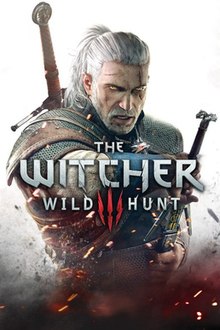 The second part of my coverage of The Witcher III: Wild Hunt's bestiary! Not really a whole ton to say in the introduction since I've said most of what I had to say before, so click here for the first part of this series, where we cover the monsters categorized in the Witcher world as 'beasts', 'cursed ones', 'draconid', 'elementa', 'hybrid' and 'insectoid'.
The second part of my coverage of The Witcher III: Wild Hunt's bestiary! Not really a whole ton to say in the introduction since I've said most of what I had to say before, so click here for the first part of this series, where we cover the monsters categorized in the Witcher world as 'beasts', 'cursed ones', 'draconid', 'elementa', 'hybrid' and 'insectoid'.This one covers the Necrophages, Vampires, Specters, Ogroids and Relicts, and aside from the ogroids (which are just giants and ogre-esque beings) all of these are pretty much more supernatural-themed spooky enemies. So yeah, there's a fair bit to talk about here!
Depending when I end up playing the DLC, expect monsters from those to eventually end up being made into a reviewing monsters segment of their own. Also, again, worth noting that Witcher III actually has a lot of human (or, well, humanoid) enemies but they don't really fit with our scope in covering and reviewing the flavour and design of monsters. So yeah.
- Click here for the first part of Witcher III's bestiary.
- Click here for Hearts of Stone.
- Click here for other reviewing monsters.
____________________________________________
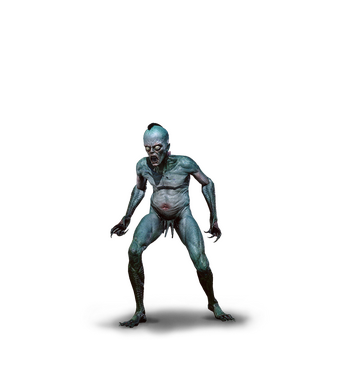
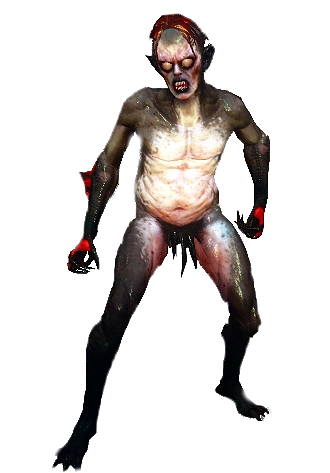
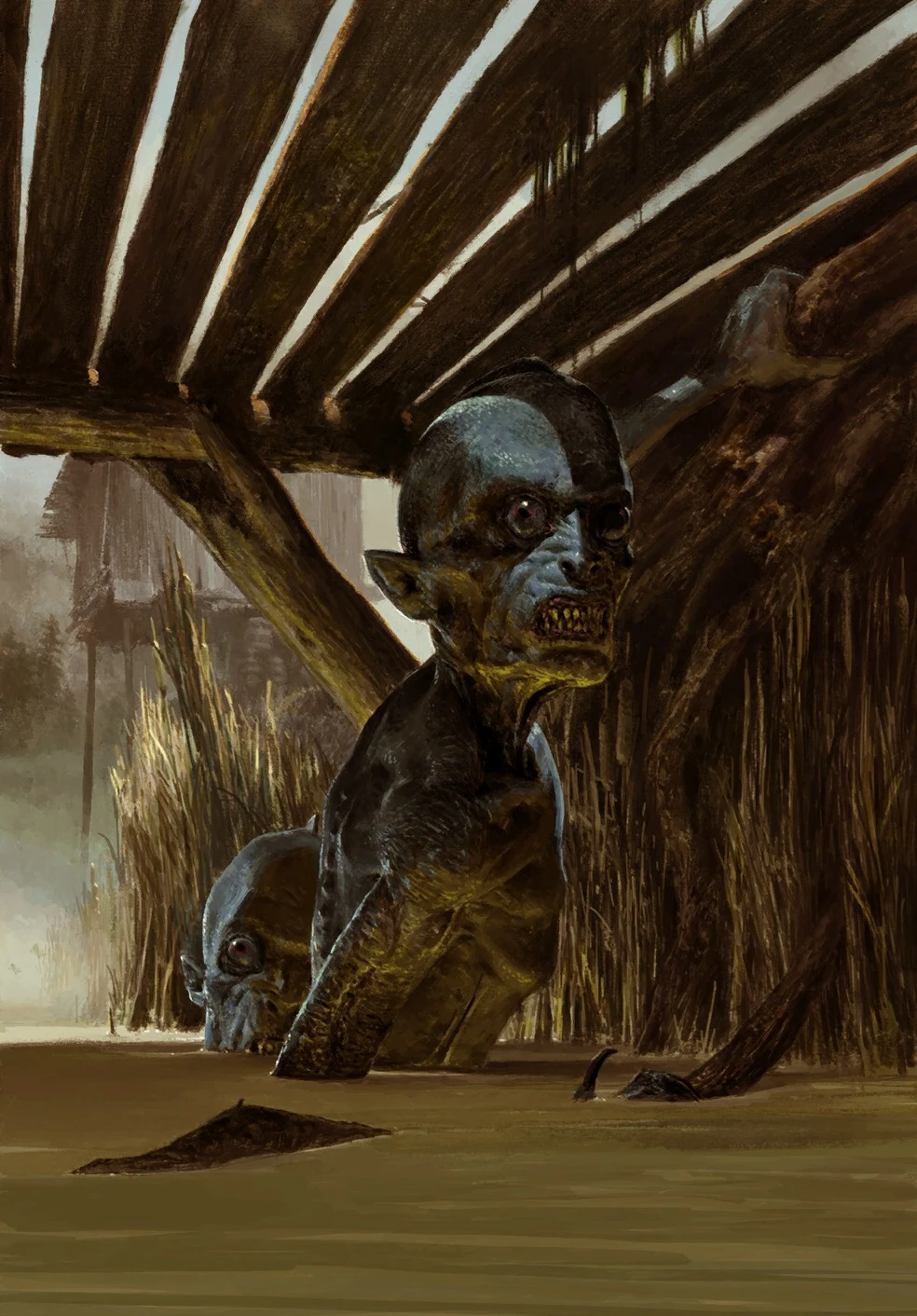
Drowner
Easily the quintessential weak enemy in these Witcher games after you've quickly outgrown wolves and wild dogs are the Drowners, water-themed zombies that appear in all three Witcher games. The Drowners are basically white-eyes corpses with blue skin and emancipated flesh, supposedly representing men who died drowning in the swamps. While the Drowners in the first game had huge fish-fins that made them look more like fish-men monsters and Drowners in the second game were just zombies, the Drowners in this game are sort of the middle ground. The basic Drowners had little nubby fins on their arms and back, while the stronger variants (Drowned Dead and Mucknixer) have more prominent fins while also being white and red in coloration. And they are everywhere in the land of the Witcher, inhabiting the witch-controlled swamps of Velen and swimming in any body of water. Oh yeah, swimming is a new gameplay feature in Witcher III, and turns out that swordfighting and spellcasting underwater is impossible, making the usually-weak Drowner suddenly a bit more threatening in their natural habitat... at least until you figure out that crossbows still work underwater.
Apparently, Witcher III's bestiary notes that Drowners are not actually the zombified corpses of drowned humans, but rather, an anatomy lesson tells us that Drowners are an entirely foreign species, in no small part due to the fish-men anatomy they have... but they're, in the bestiary's words, 'no more intelligent than a carp'. Which, I feel, actually makes them a bit less interesting, but okay, sure. They're the first of our Necrophages, literally meaning 'corpse-eater', which is basically what they do... although, again, basically all the necrophages in the world of the Witcher are very much willing to turn living humans that are not corpses into corpses. I do like the description how they will sometimes keep their corpses under the water to 'age' them until they become rotten and tender. In-game, the Drowners all behave exactly the same, charging at you and swiping at you and sometimes hiding in the muck to burst out nearby. They're really only dangerous in large numbers. The bestiary describes another variant that doesn't appear in the game, the Vodnik. The term used for the Drowners in the original Polish version is Utopiec, alternatively Vodnik. Neat!
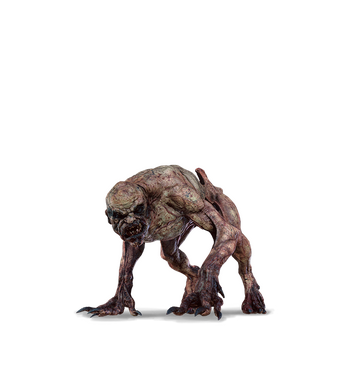
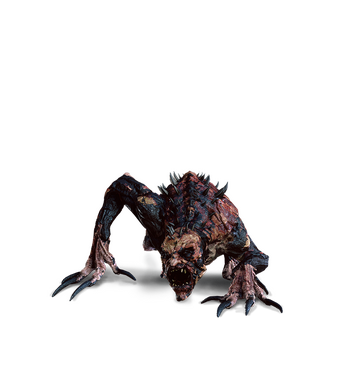
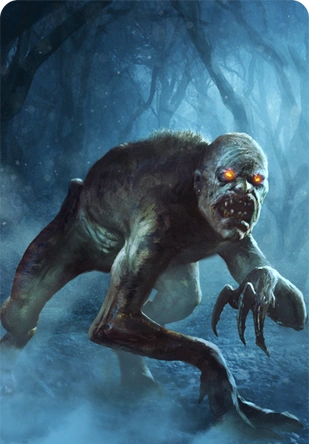
Apparently, Witcher III's bestiary notes that Drowners are not actually the zombified corpses of drowned humans, but rather, an anatomy lesson tells us that Drowners are an entirely foreign species, in no small part due to the fish-men anatomy they have... but they're, in the bestiary's words, 'no more intelligent than a carp'. Which, I feel, actually makes them a bit less interesting, but okay, sure. They're the first of our Necrophages, literally meaning 'corpse-eater', which is basically what they do... although, again, basically all the necrophages in the world of the Witcher are very much willing to turn living humans that are not corpses into corpses. I do like the description how they will sometimes keep their corpses under the water to 'age' them until they become rotten and tender. In-game, the Drowners all behave exactly the same, charging at you and swiping at you and sometimes hiding in the muck to burst out nearby. They're really only dangerous in large numbers. The bestiary describes another variant that doesn't appear in the game, the Vodnik. The term used for the Drowners in the original Polish version is Utopiec, alternatively Vodnik. Neat!



Ghoul & Alghoul
A very common undead monster taken from Arabic myths is perhaps the poster boy for the term 'necrophage', hideous, twisted mockeries of what used to be humans, now dwelling in graveyards to consume dead flesh. They appeared in the first game but were missing in the second (and I think were meant to be replaced by the Nekkers) but return in their hideous, gangly glory in this game. Again, like the Drowners, Ghouls aren't actually transformed humans but rather more of the whole 'post-Conjunction' creatures, beings that were originally from other planes that found themselves stranded in the human world and essentially established themselves as an invasive species. Also, for some reason, they get extra-powerful at night. Hey, they're ghouls, they don't need to follow normal logic. Ghouls are almost always found hunting corpses, and since there's a huge war going on, a huge theme of Geralt's earlier quests as he goes through the war-torn countryside is to help out the survivors clear out packs of ghouls that are ready and willing to feast on the massive amount of dead bodies everywhere. And, hey, ghouls are very much willing to attack catacombs and graveyards to dig up more bodies, and, like Drowners, are very much willing to turn any living peasant into more bodies.
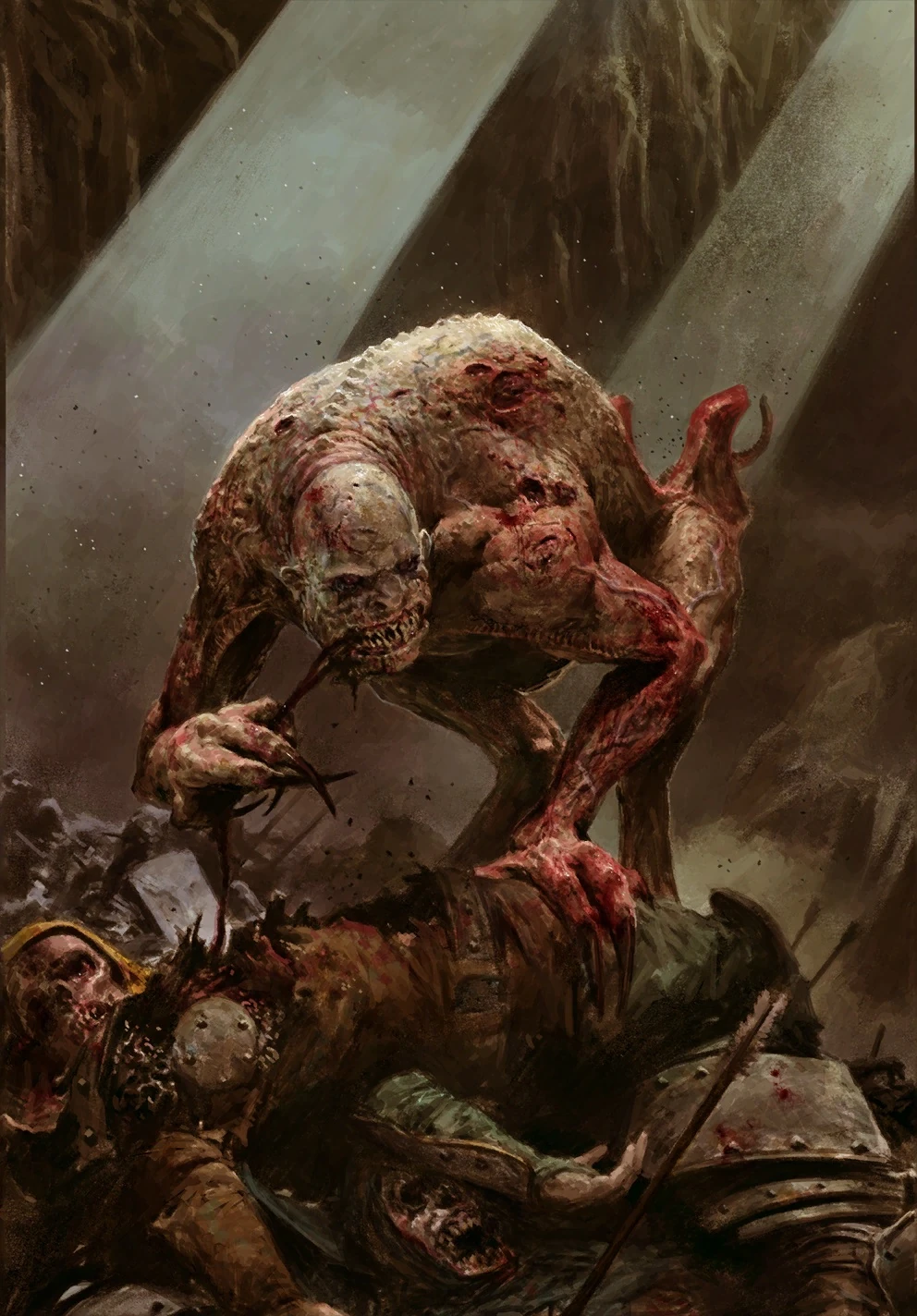
Stronger versions will show up later, called Alghouls (Ra's al Ghul, anyone?), described by Geralt's friend Yarpen Zigrin as 'basically a badarse ghoul'. Unlike most variant enemies, Alghouls have a unique model and a separate entry in the bestiary! And in addition to being bigger, Alghouls are noted to actually be smarter, able to lead their ghoul buddies, and they have spines running down their body that can stab Geralt if he strikes at them in the wrong position. Also, Alghouls are able to screech and drive its ghoul pack into attacking more fiercely. Anyway, pretty cool, and the animation showing them scrambling around like mad dog-monkeys is pretty nasty. I like them.
The bestiary entry for ghouls describes a variant known as a 'Graveir' and the alghoul entry also describes a variant known as a 'Cemetaur', but none of these appear in Witcher III, and are actually nods to enemies from the first Witcher game.

Stronger versions will show up later, called Alghouls (Ra's al Ghul, anyone?), described by Geralt's friend Yarpen Zigrin as 'basically a badarse ghoul'. Unlike most variant enemies, Alghouls have a unique model and a separate entry in the bestiary! And in addition to being bigger, Alghouls are noted to actually be smarter, able to lead their ghoul buddies, and they have spines running down their body that can stab Geralt if he strikes at them in the wrong position. Also, Alghouls are able to screech and drive its ghoul pack into attacking more fiercely. Anyway, pretty cool, and the animation showing them scrambling around like mad dog-monkeys is pretty nasty. I like them.
The bestiary entry for ghouls describes a variant known as a 'Graveir' and the alghoul entry also describes a variant known as a 'Cemetaur', but none of these appear in Witcher III, and are actually nods to enemies from the first Witcher game.
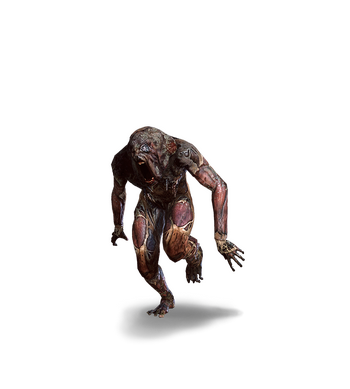
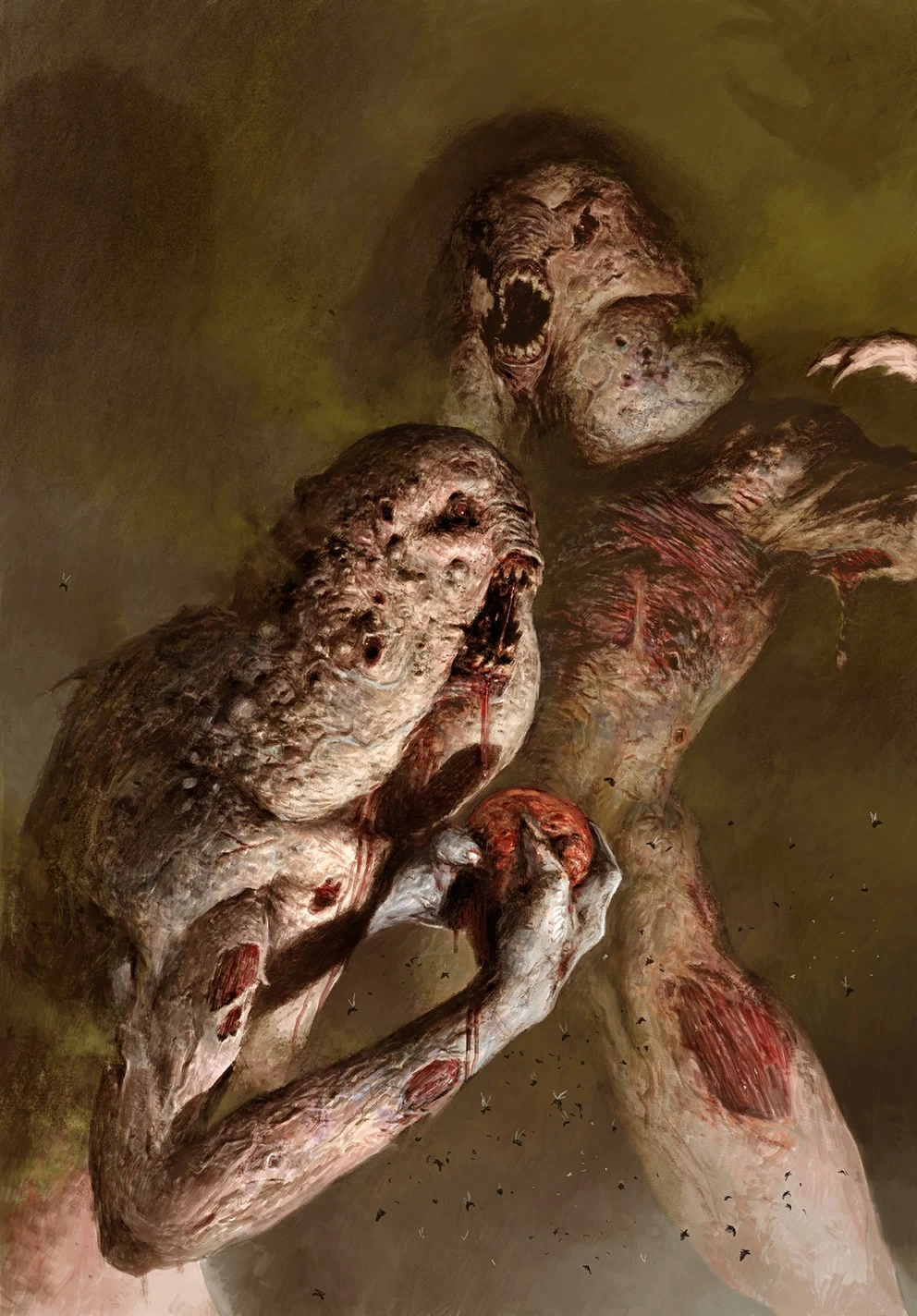
Rotfiend
Another returning enemy from Witcher II are the Rotfiends and their more powerful variants, the Devourers. And they're still basically the same with how they behaved in Witcher II, being flayed corpses showing muscles all over, with a bloated, mutated head that's all flabby around their visible mouth. Look at that Gwent art, which really highlights a close-up of a Rotfiend's disgusting heads in full glory. It's noted that Rotfiends and Devourers basically became more and more common as the war spread prior to Witcher III, which is a neat way of explaining why they're so common by the time of Witcher II and Witcher III when they never appeared in the novels or the first game. They sort of behave similarly to ghouls, hunting corpses and sometimes attacking the living, and are deceptively fast despite looking like zombies. And just like in the second game, upon being close to death, the Rotfiend's body will balloon up disgustingly and explode into a gigantic poisonous cloud. Pretty nasty, and I do like that they actually look pretty different from any other enemy in the game.
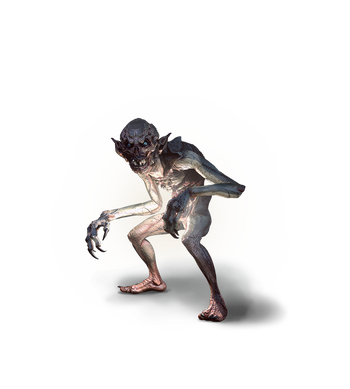
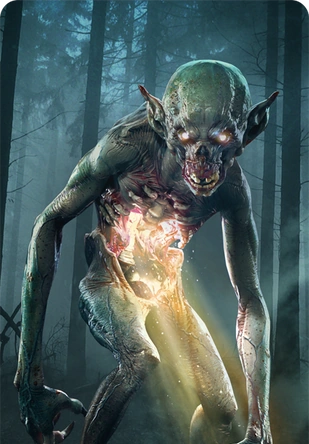
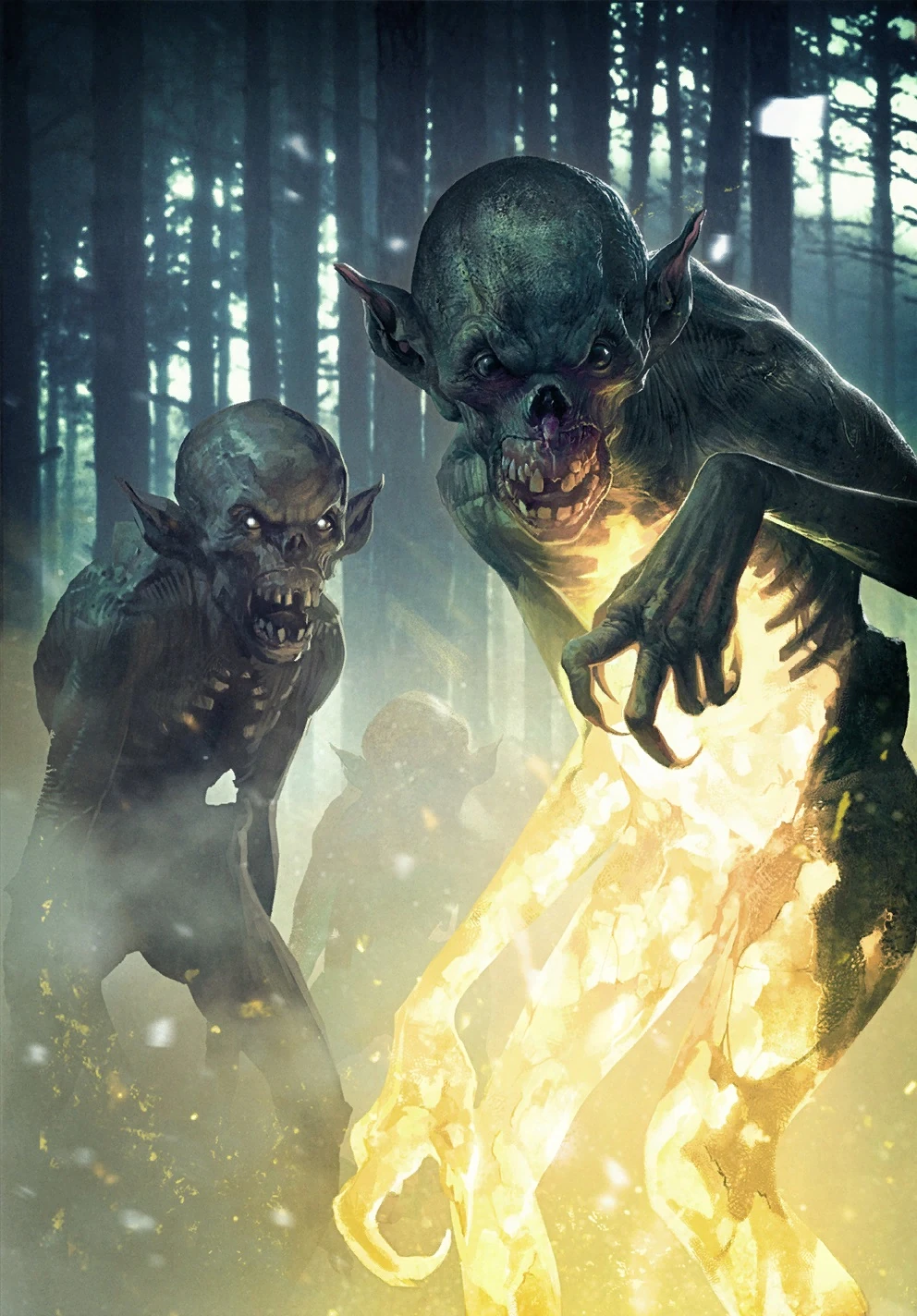
Foglet
Foglets (and their stronger variants, the Tangalores) are pretty interesting creatures! The first time you meet them they appear in nothing but a rolling cloud of fog, and then they suddenly burst into being, alternating from being a semi-solid humanoid form made out of fog or their true form, emancipated ghoul-goblin humanoids with a torso and abdomen that are torn wide open and are glowing. Not based on any specific mythological creature that I can tell, the Foglets are pretty damn cool. In addition to basically being pretty flavourful -- a malicious spirit that manifests in a fog that waylays travelers is the sort of inspiration that I would totally believe is a real-life superstition. They can live for a long, long time (Geralt fights an exceptionally ancient one at one point) and they can actually turn into the mist that they are named for.
While in the game Foglets are always just jump and attack Geralt, the bestiary talks about how they often pretend to be some will-o-wisp-esque lights to lure their prey to quicksands where they will drown, or enjoy in simply driving travelers to madness by disorienting and causing them to be unable to escape the bogs they live in. I actually do really enjoy fighting Foglets, because the more you fight them the more you realize that there is a part of the rolling fog that is the Foglet's "true" body that moves independently of the other fog, and you can basically force the Foglet to appear by using specific magic or grenades. It's not necessary and by and by you'll be served as well by just waiting for them to appear and dashing towards them, but it feels a lot cooler, y'know?
While in the game Foglets are always just jump and attack Geralt, the bestiary talks about how they often pretend to be some will-o-wisp-esque lights to lure their prey to quicksands where they will drown, or enjoy in simply driving travelers to madness by disorienting and causing them to be unable to escape the bogs they live in. I actually do really enjoy fighting Foglets, because the more you fight them the more you realize that there is a part of the rolling fog that is the Foglet's "true" body that moves independently of the other fog, and you can basically force the Foglet to appear by using specific magic or grenades. It's not necessary and by and by you'll be served as well by just waiting for them to appear and dashing towards them, but it feels a lot cooler, y'know?
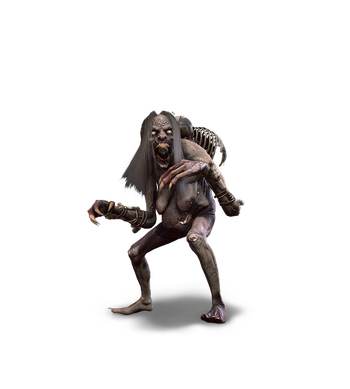
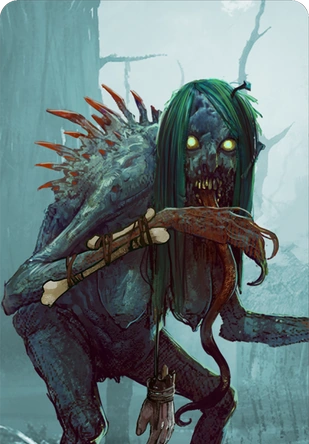
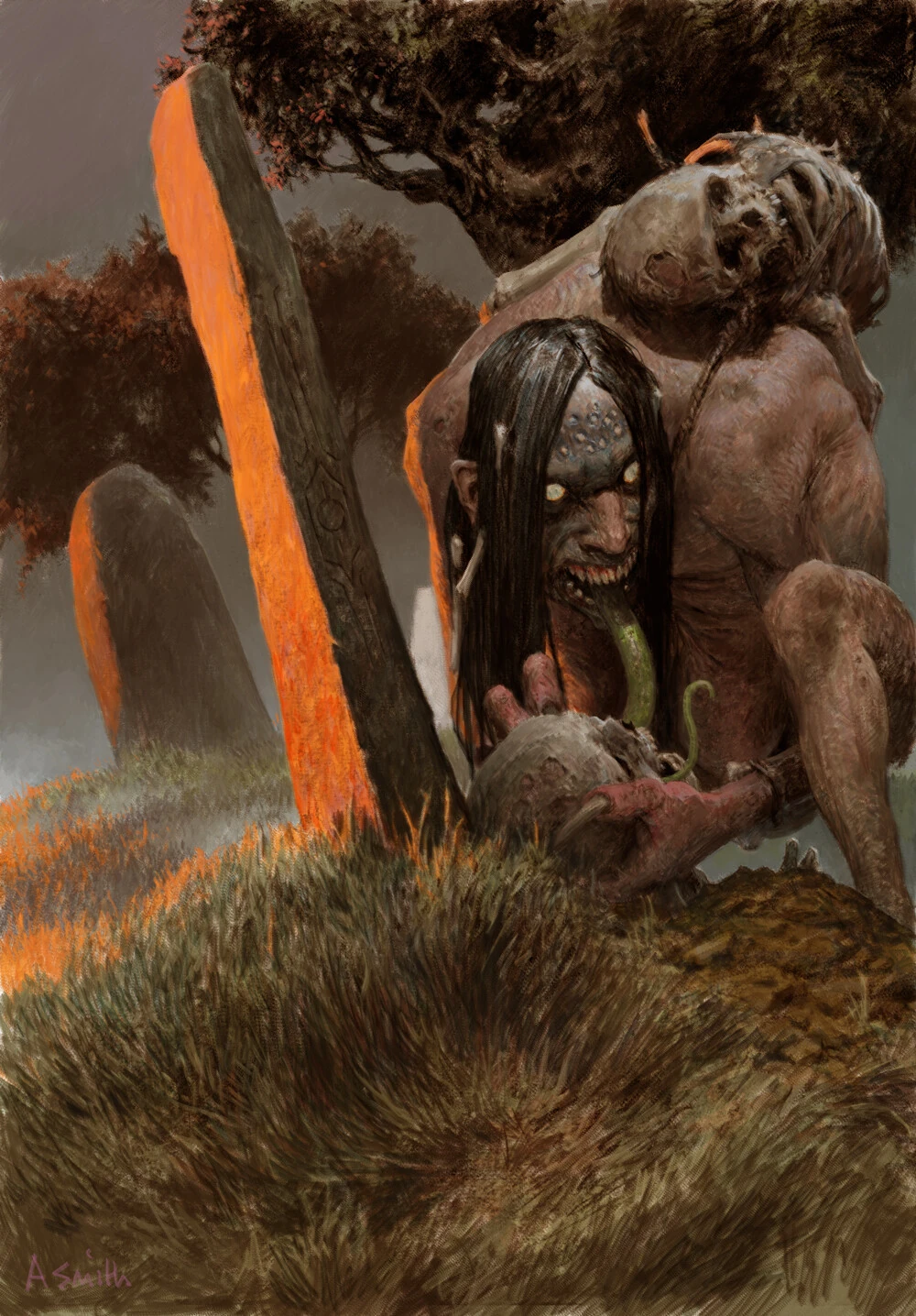
Grave Hag
The original term for 'hag' is meant to mean 'witch', some mysterious old crone that lives in the wood and are strange, fairy-like tricksters at best and curse-casting, child-eating monsters at worst. In Witcher III you'll actually meet actual, sentient and villainous witches (which we'll cover in the Relicts section), but some Necrophages actually end up looking like wizened old women with gross, saggy breats and emancipated limbs. And between the long claws and the saggy bags of flesh, they really look very gross. Grave Hags will seek out graveyards because humans are foolish enough to leave these sweet, sweet dead bodies buried under the ground and it's just right there, ripe for some midnight snacking. Once a Grave Hag has exhausted a graveyard's supply of bone marrow, it'll start killing the people in the nearby village and burying them in the ground to make them into delicious, decomposed corpses. Interestingly, one of the named Grave Hags implies that the entire species are actually sentient and capable of speech and conversation.
In combat, in addition to looking very creepy, Grave Hags have a very long, prehensile tongue that the bestiary notes is something they use to suck out marrow from long bones. These actually will surprise you the first time you fight them because the range of the tongue whip is pretty far and they can actually 'blind' Geralt for a bit. And, well, if you're quick enough with your swordplay, Geralt will be able to hold onto the tongue and slice it right off.
In combat, in addition to looking very creepy, Grave Hags have a very long, prehensile tongue that the bestiary notes is something they use to suck out marrow from long bones. These actually will surprise you the first time you fight them because the range of the tongue whip is pretty far and they can actually 'blind' Geralt for a bit. And, well, if you're quick enough with your swordplay, Geralt will be able to hold onto the tongue and slice it right off.
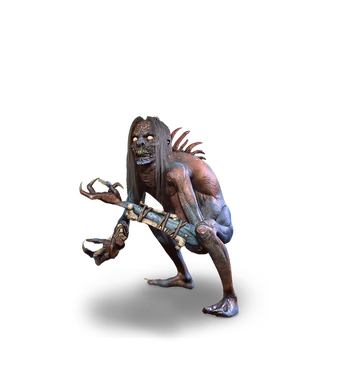
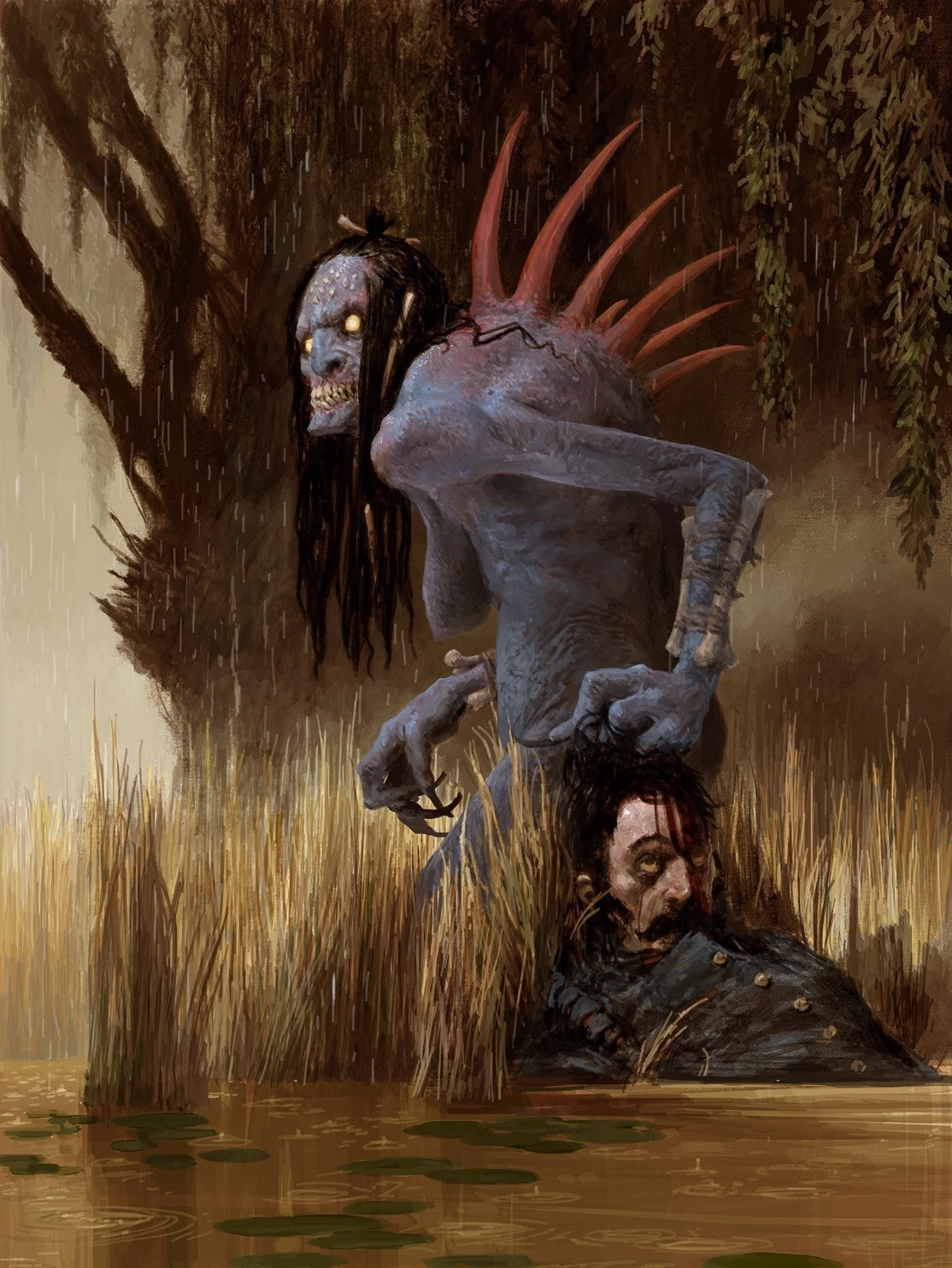
Water Hag
A palette swap of the Grave Hag but no less gruesome is the Water Hag (and their stronger sisters, the Bilge Hags), who, as her name implies, lives in bogs and swamps. The game itself offers various origins about where the Water Hags come from. The quote in the in-game bestiary notes that the Water Hags are simply 'drowners' wives', implying them to be the female version of the drowner (and Water Hags are often found commanding small groups of Drowners). One character in the game gives a folktale-esque origin, noting that they are drunk women that wander into the swamps, and are subsequently cursed. And while playing the game, depending on your choices you'll actually see a human character get transformed by the super-powerful Crones below into a water hag. And a tie-in guidebook notes that they are originally beautiful fairies called naiads who fell in love with mortal men and lost their eternal youth. Whether any, none or all of them are true, the Water Hags are pretty nasty.
I also do like the bestiary's scoffing attitude to yet another in-universe folktale about the Water Hags masquerading as lost old women to fool travelers into taking shelter in their shack, because Water Hags are, well, pretty vile, ghoulish creatures reeking of carrion and rot. They don't have the tongue attack that their grave hag sisters have, but they share the 'submerge and reappear' trick that their Drowner minions can do, and can throw balls of mud that'll block the screen. At least I hope it's just mud. The hags look disgusting and nasty, but honestly? They feel pretty flavourful and fit pretty much right into the general folk-tale monster vibe of most of Witcher's creatures.
________________________________
Ogroids
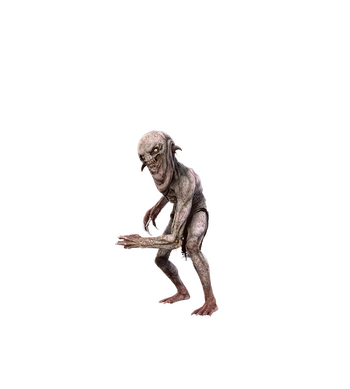
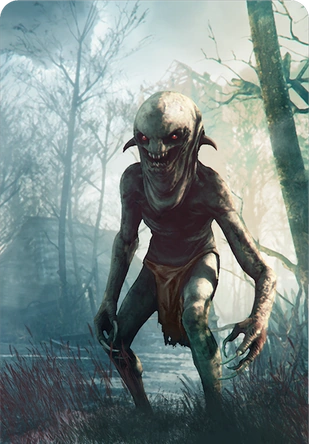
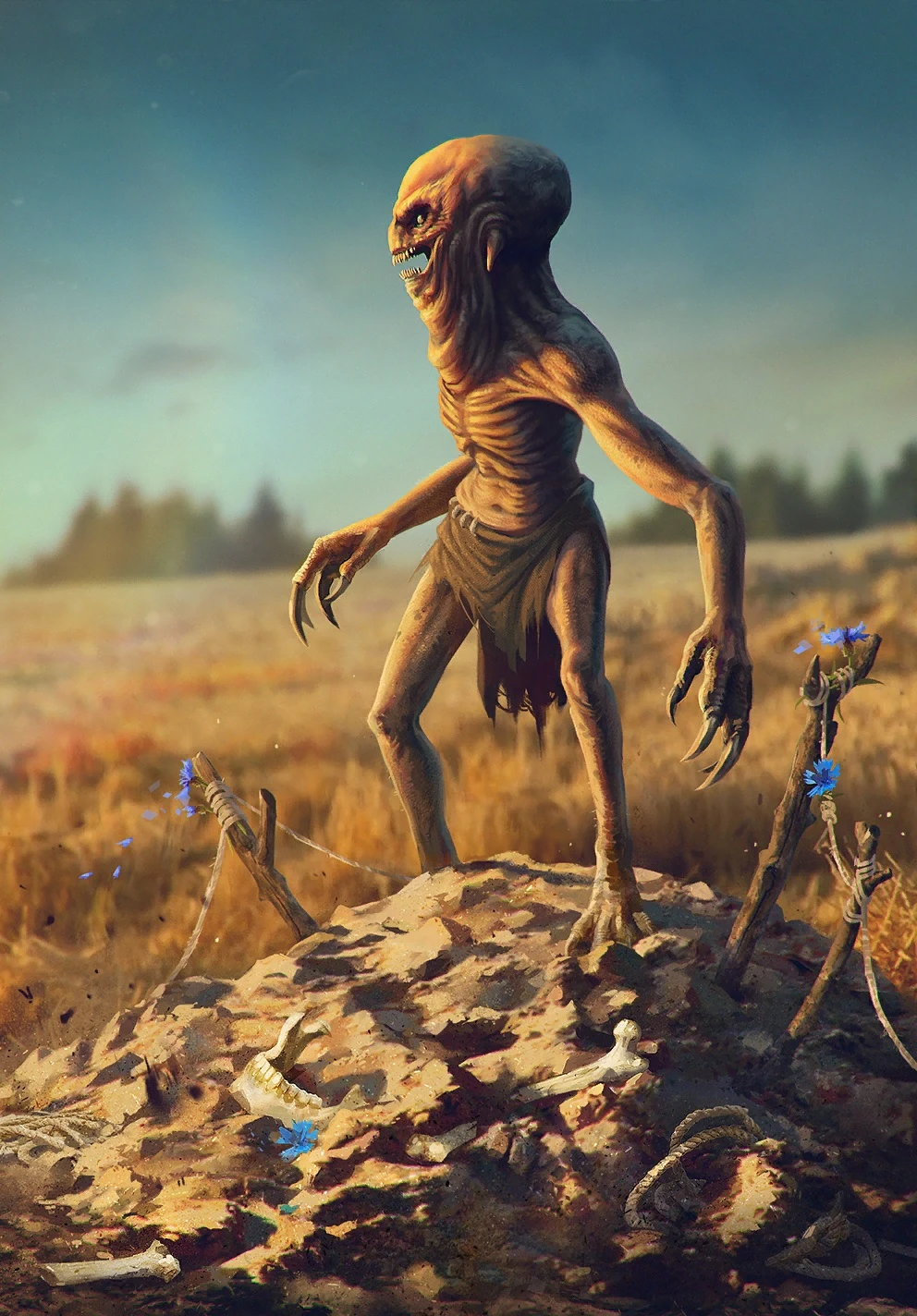
Nekker
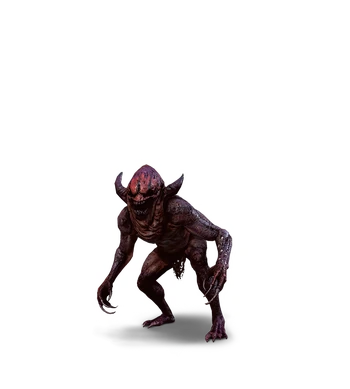 Originally classified among 'other' and baffling me why they weren't classified among the necrophages, the Nekkers are finally slotted among the 'ogroids' in Witcher III. I guess they're just found around corpses of their victims, and they don't eat them like ghouls and rotfiends, then. They're mostly the same as what they were in Witcher II, being ghoulish, pale-skinned humanoids with long arms and drooping, disgusting neck parts. As with Witcher II, stronger versions are called Nekker Warriors and they are red with upwards-pointing ears. The bestiary also describes Phoocas, a Nekker variant based on the shape-shifting Púca from Celtic mythology, but they don't appear in the game.
Originally classified among 'other' and baffling me why they weren't classified among the necrophages, the Nekkers are finally slotted among the 'ogroids' in Witcher III. I guess they're just found around corpses of their victims, and they don't eat them like ghouls and rotfiends, then. They're mostly the same as what they were in Witcher II, being ghoulish, pale-skinned humanoids with long arms and drooping, disgusting neck parts. As with Witcher II, stronger versions are called Nekker Warriors and they are red with upwards-pointing ears. The bestiary also describes Phoocas, a Nekker variant based on the shape-shifting Púca from Celtic mythology, but they don't appear in the game.Again, they're mostly just there as generic 'they will slash you, slash them till they die' enemies. Like Drowners, they can bury under the ground to hide from Geralt and then ambush attack him. They emerge from weird anthill-like mounds that Geralt can destroy with his bombs, which, in Witcher II shows us that they live in subterranean caves. So I guess they're like, nasty mini-goblins that can burrow through the ground like a colony of nasty, rabid meerkats, then? Okay.
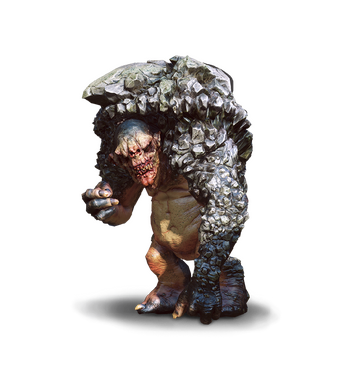
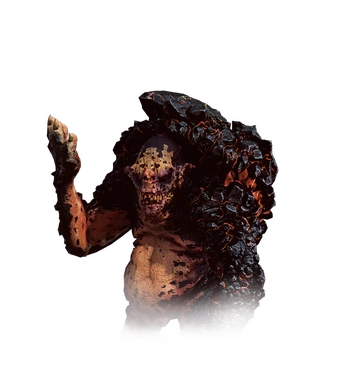
Rock Troll
My favourite enemy from Witcher II makes a return here, and they've gotten a bit of a revamp, being more explicitly made partly of rock instead of just being a big, lumbering oaf-like humanoid. I do like this version a bit better because it's simply a bit more distinctive, and, of course, rock trolls tend to hide and disguise themselves as huge rock formations. As with trolls in Witcher II (which are, I guess, just a different sub-species of trolls), rock trolls are intelligent, sentient beings even if their language capabilities and understanding of civilization might be lacking. There are a couple of always-hostile trolls, but, again, for the most part a lot of the trolls you meet like Bart or Trollololo (no, really) are pretty decent people that just happen to be rocky brutes... and even when they fight, kill and turn men into stew, usually there's some reasoning behind it, like self-defense or accident. I really love them, and it's clear that the voice actors and script-writers had a lot of fun writing them. Again, not all trolls are misunderstood, and some are straight-up hostile.. but man, I find that for the most part, I end up sparing trolls more than I do killing them. Which is not to say that all of the rock trolls are forgivable (some are actually nasty), but I like that the game gives you an option to spare these lovable lugs. They're no less people than dwarves or dopplers are, after all.
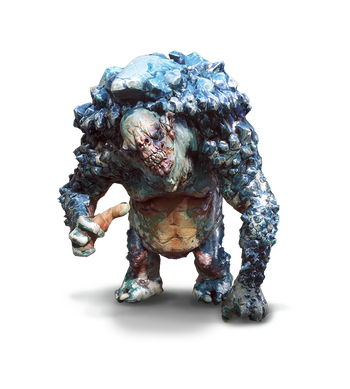
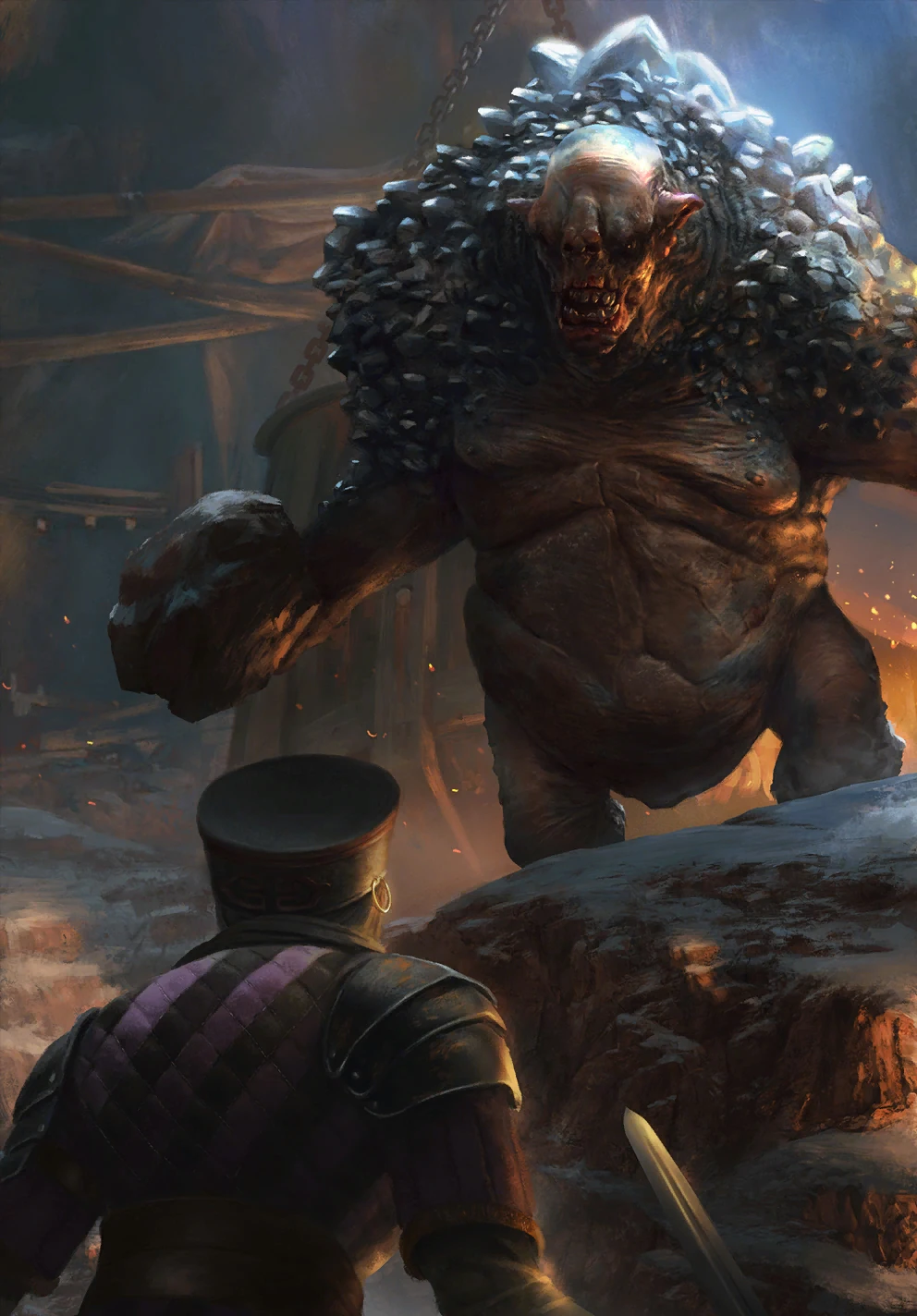
Ice Troll
Skellige Isles gives us a variant of the Rock Trolls where instead of being covered with rocky growth, these guys have permafrost around their backs and arms. And where the rock trolls might be gentle (or at least mean to be gentle), ice trolls are always hostile and will eat any human that passes through their territory. Unlike rock trolls, they can't speak the common human language, although the bestiary itself isn't sure if that's simply because they live so secluded from humans, or if it's because of some curse from the location they live in. In combat they're basically the same with rock trolls, but apparently 'draw power from the blizzards' and become faster and stronger depending on the weather. Neato.
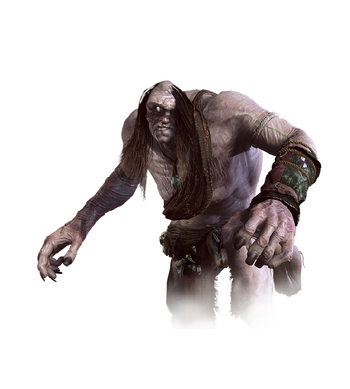

Cyclops
"Ogroids", with the exception of the Nekkers, seems to just mean anything that's a giant. And one of the simpler variants is the Cyclops, taken straight from Greek mythology. These giants are... well, they're as hard to fight as you'd imagine a giant would be. Immensely durable, they can slap and throw your around, they can run and jump really far, and your sword slashes tend to do minimal damage to them. The Cyclops really doesn't have anything overly special beyond the whole fact that they only have one eye, but man, that sure is a nasty-looking take on a 'one-eyed face' look, yeah? Instead of being symmetrical, Witcher III's Cyclops' face has the nose bent away and the single eye still on one side of the nose. It looks less like a giant that happens to have one eye, and more like through some hideous mutation, one of the cyclops' eyes have disappeared and the other eye grew larger to push the rest of the face aside. It's pretty creepy-looking.
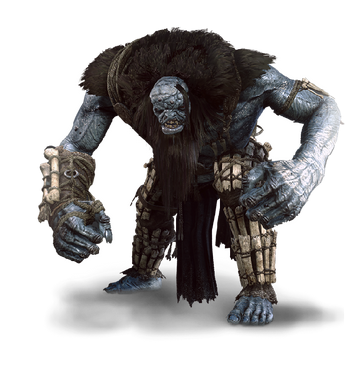
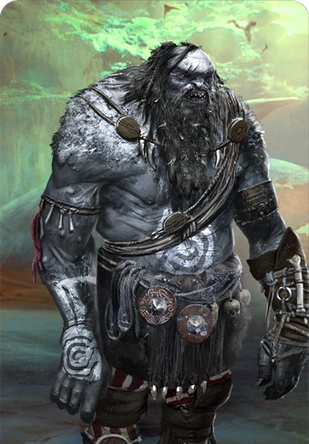

Ice Giant
The Skellige Isles is based on Old Norse mythology, and, of course, one of the most common foes faced by the gods of Norse mythology are the Jotunn, often translated as 'frost giants'. So of course the Skellige Isles have their own take on these beings! Or, rather an Ice Giant that's met as part of a pretty major quest. The design is honestly nothing too special, and behaviour-wise it's basically a reskinned Cyclops. But on the other hand, you really don't need a whole ton to really sell the fantasy of an Ice Giant, do you? I do quite like the runic tattoos and the armour made seemingly out of human bones. Apparently, the one that Geralt faces is likely to be the last one of its kind, and one that swings around a dang anchor chain like one would swing a morningstar. Pretty cool boss fight, even if he's just basically kind of just a giant.
________________________________
Relicts
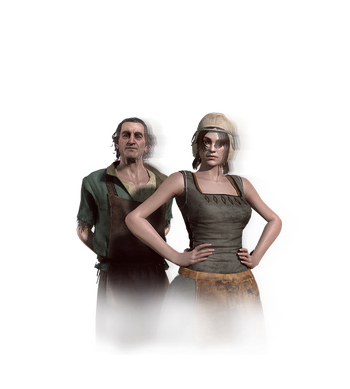
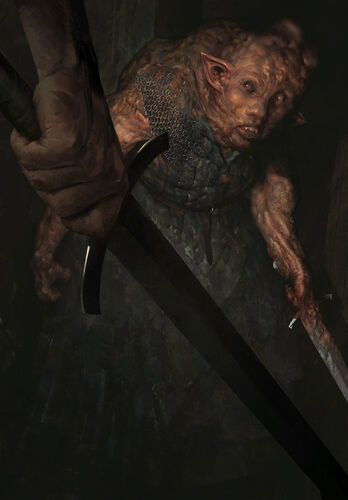
Doppler
Now we enter perhaps one of the more interesting parts of the categorization, 'relicts', which seem to mean... ancient beings? Endangered beings? Whatever the case, I think they're meant to be something that's a bit more... natural. Unlike the necrophages or cursed ones, these seem to lean more towards beings that are sort of already living in the world, perhaps even before humans arrived. One of the more prominent one in the franchise are Dopplers, also known as shifters, changelings or vexlings, and they're extremely prominently featured in both the novels and the Netflix TV series. And one of Geralt's allies in the game is Dudu the Doppler. It's kind of interesting that Dopplers are counted and listed in the bestiary while elves, dwarves and halflings aren't, but okay, sure.
In Witcher III you never actually see Dopplers in their natural form, described as looking hideous, like bald midgets with elongated limbs, tongues and noses. (Netflix's take looks like this) And Dopplers are an endangered race, but the survivors are pretty shrewd. Apparently, they don't just merely shapeshift, but their copying abilities are so precise that they acquire physical features, voice, skills, clothes, and even the mindset and behaviour of the person they're copying -- something that they can do instinctively. This transformation is physical, and can't be dispelled with anti-illusion magic... but like most magical beings in the Witcher world, Dopplers will revert to their true form when struck with silver. But apparently, all Dopplers have timid spirits -- they might lie and cheat (and Geralt's buddy Dudu certainly helps out in cheating and acting) but they draw the line at actual conflict, and they'll avoid shedding blood at all costs. The one Doppler that Geralt ended up having a contract for (the peasants thought it was an 'imp', and Geralt scoffs at the thought that 'imps' exist... in a world with every magical beast imaginable) ends up shapeshifting into Geralt himself but ends up giving up after a couple of strikes. The Dopplers themselves are mostly interesting because of their existence, because regardless of whether they are malign or not, they end up being the target of the Witch Hunters of the Cult of Eternal Flame, and some were burnt at the stake because they were living as regular humans.
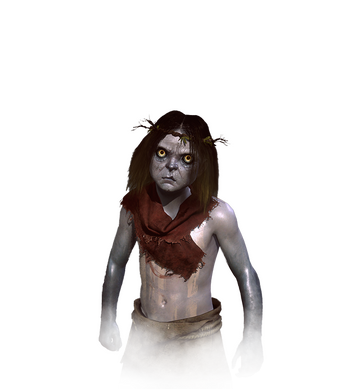
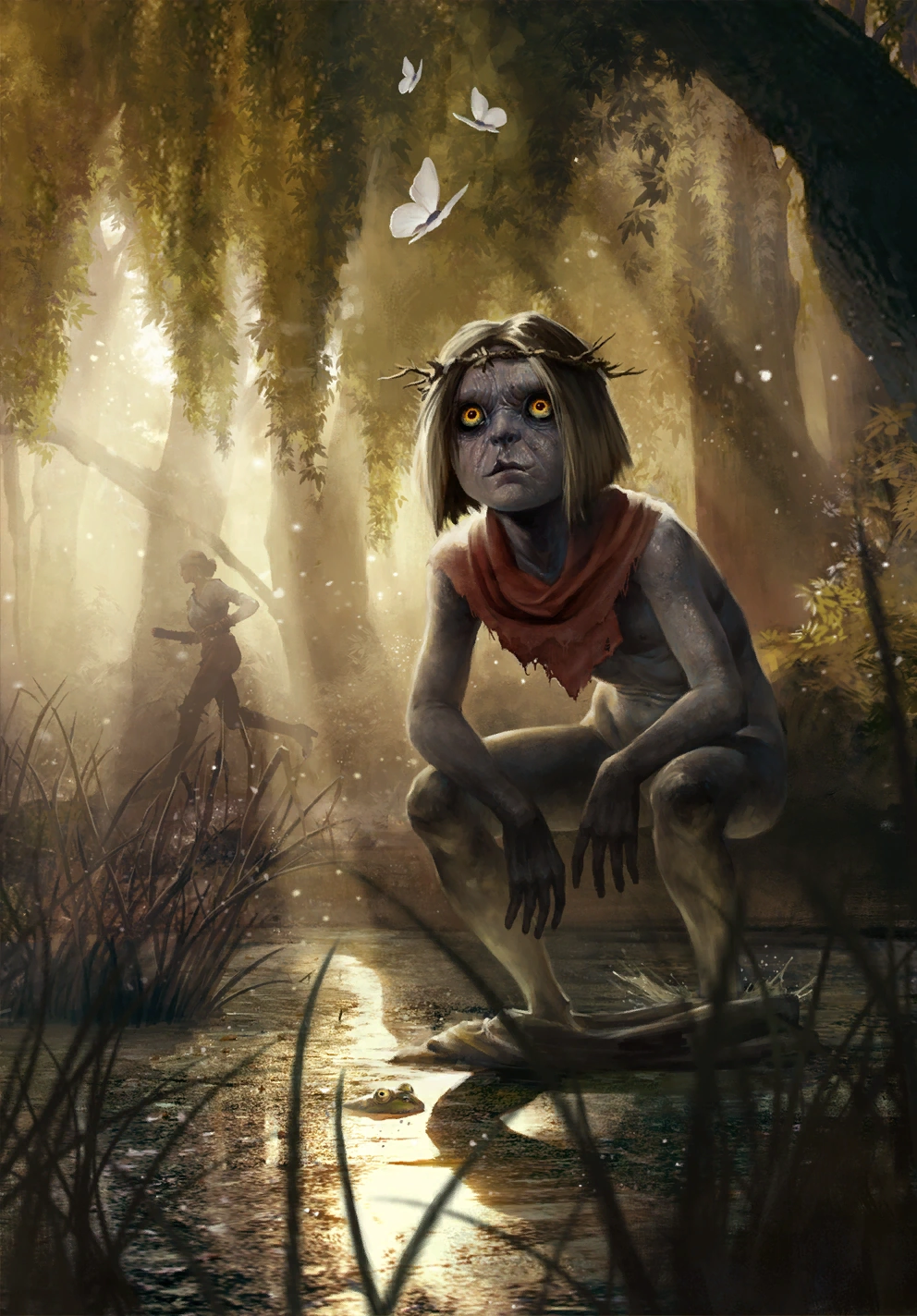
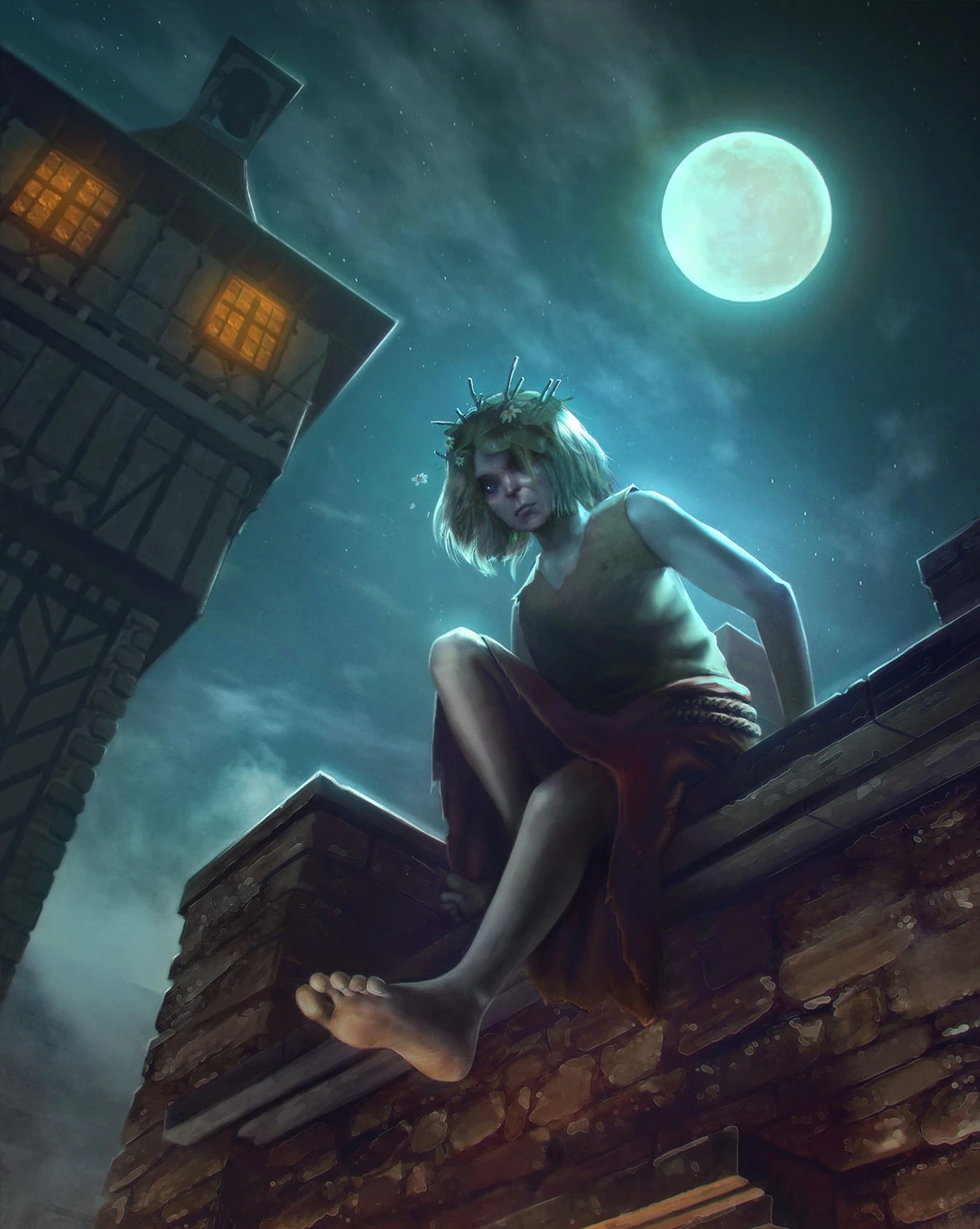
Godling
The Godlings, called Bożątko in the Polish version and based on a benign house spirit, are kinda-sorta similar to the concept, although the Godlings of Witcher III aren't always house spirit. Geralt meets two in his journey, Johnny and Sarah, one inhabiting a swamp and being a strange neutral force between the Witcher and the other inhabitants of the swamp, and another inhabiting a seemingly haunted house in Novigrad and basically playing pranks that she doesn't quite know are actually harmful. The Godlings are apparently often confused by humans for Bucca or Lutin (two different goblin-like creatures from myths), and are gray-skinned children with creepy, glowing yellow eyes surrounded by a wrinkled skin and a slightly-broken lip. And their limbs are covered in some sort of black sheen. The idea, I feel, is to make the Godling look somewhat friendly, but extremely unsettling... something that I was definitely completely prepared for. The main story mission where you first meet Johnny the Godling had you meet him not too long after the Botchling one, and I was expecting some sort of hideous creepy motherfucker. And Johnny was certainly creepy, but actually pretty benign. When you meet him the first time he's actually mute and you needed to restore his voice, but I do think that having Godlings unable to communicate by sound would be yet another thing that would make them feel so much more mysterious.
The Godlings are always mischievous, basically doing all of the things that fey creatures do. They play pranks because sometimes they think that nightmares are fun since they like being scared, and they often talk their way through a conversation while talking about silly, gross children's toilet humour. Godlings are drawn to joy and innocence, often showing themselves and playing alongside kids, and they will perform small services for those in their care, being happy in getting respect, food or cast-off tools, and hate rudeness. While the bestiary notes that godlings hate the noise of civilization, at least Sarah is content to live in a house in a populated city, although she does limit the amount of people she allows into her house. While they don't seem like they are able to fight, the fact that the ancient Crones of Crookback Bog can't actually kill Johnny and had to settle for stealing his voice does imply that they might just actually be extremely powerful.
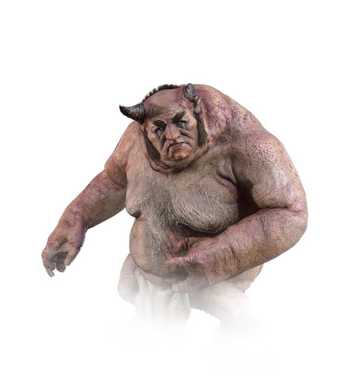
Sylvan
Described as basically looking like satyrs or fauns in the books, Sylvans in Witcher III are still humanoid beings with a goat's horns and feet... but they're also super-corpulent and hunchbacked. Which, considering they are natural creatures that are hedonistic and lazy, makes more sense than the traditional look of them looking more athletic. Apparently, they are often thought to be 'devils' by silly peasants, and they tend to hang out with elves and whatnot. Sylvans and Yakshas (again, another mythological creature that doesn't appear in the game itself) tend to hang out in forests and avoid confrontation, although Geralt does meet one that poses as a god-like being to fool peasants into bringing them food. In combat, they're basically tanks and can for some reason breathe fire.
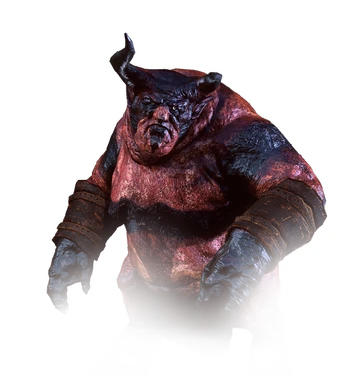
Devil?One named creature I wasn't sure I should lump with the rest of his species is Fugas. He's clearly a reskinned version of a Sylvan, but his model is so different -- longer horns, a combination of blood-red and black skin, and far, far more hateful and malicious than any Sylvan you meet, being a minion of the Crones of Crookbag Bog. The bestiary and character bios list Fugas as a straight-up 'devil', and I'm not sure if that's in reference to his species, or to the fact that in-universe -- and the novels, at least -- sylvans are often mistaken for devils. I did find him to look pretty cool and a fair bit more memorable than most of the one-off slightly-modified monsters.
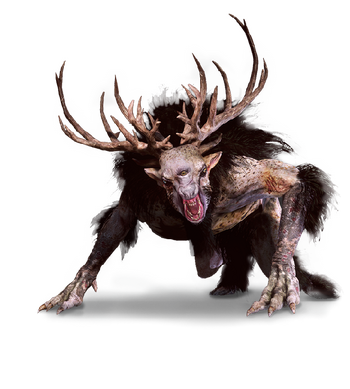
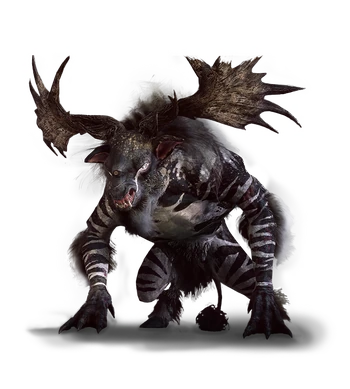
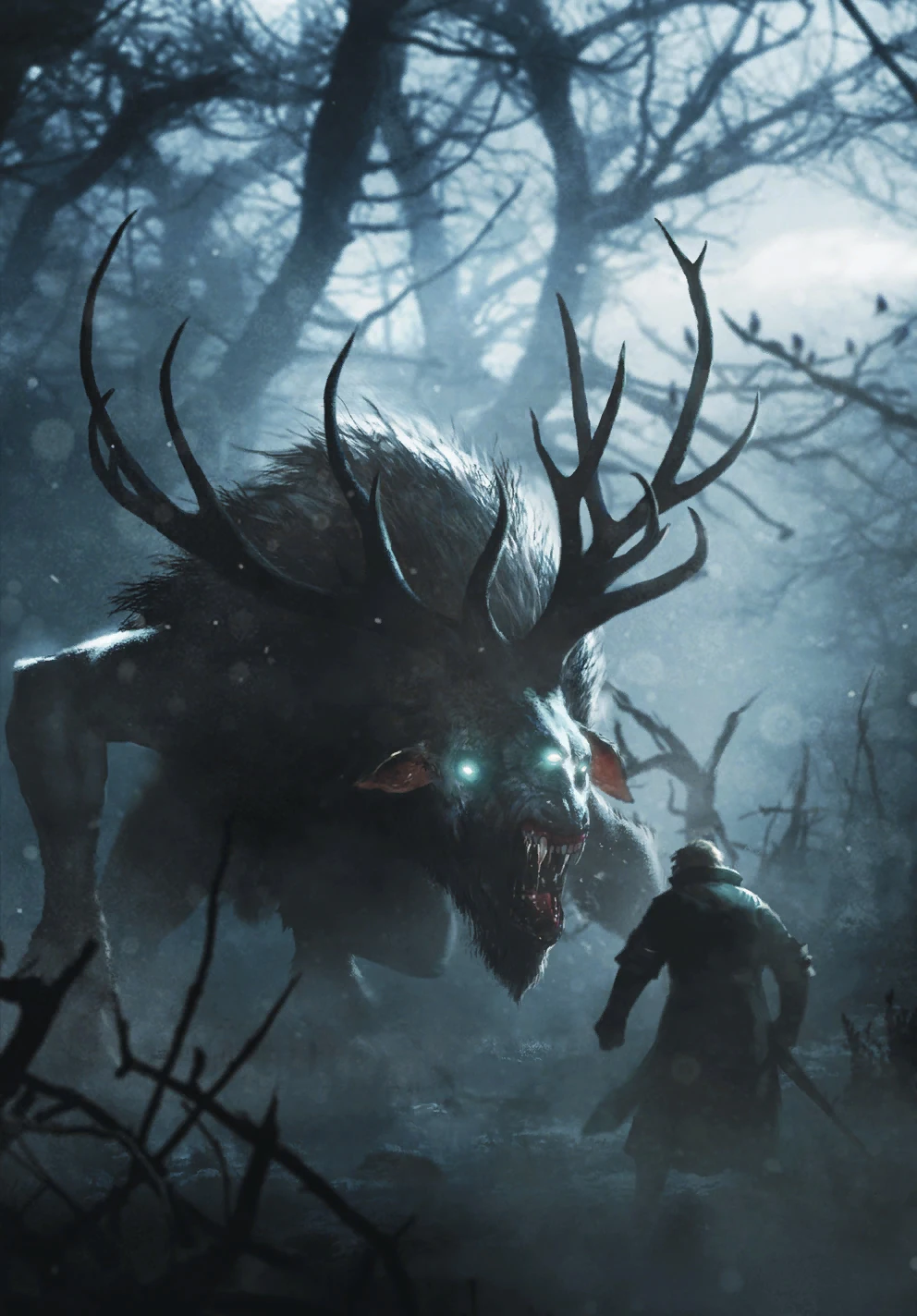
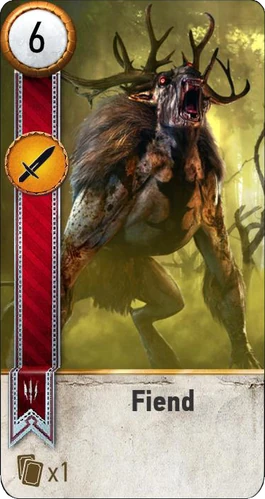 Fiend
FiendI have been so used to 'fiend' being a synonym for demons in fantasy work, but the fiends in the land of the Witcher are these monstrous humanoid beasts with the face of... well, a fiend, I guess. It's got giant antlers, hair around its pale skin, and the size of a small car. I do like that the face is kind of ambiguous, and I'm not sure if it's based on an ungulate like most of the Fiend's design, or on like a cat skull or something. Fiends and their cousins, Bumbakvetches (yet another variant that doesn't show up) live in swamps and forests, hiding mostly away from humans, but willing to slay and attack them should there be the opportunity. And
In addition to being gigantic and able to toss mere humans around, Fiends also have a Wolverine-style healing factor, able to heal quickly from wounds, and also a third eye at the center of its forehead -- which allows the fiend to hypnotize its prey and lull them into standing still before the Fiend rips you to shreds. Apparently, fiends are also afraid of loud noises, so Geralt's grenades can chase fiends away. Very, very cool, and the fact that they are pretty rare in the game makes the fight with a fiend pretty interesting. Worth noting is the unique fiend Morvudd, found in Skellige. He's got zebra skin and the antlers of a moose. A very, very cool variation that fits with the whole deer theme of the fiends.
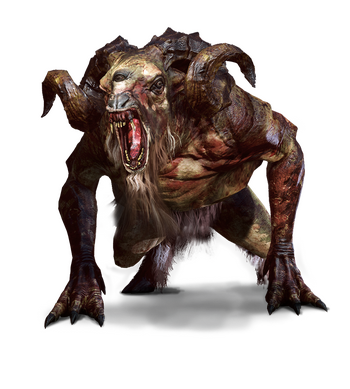
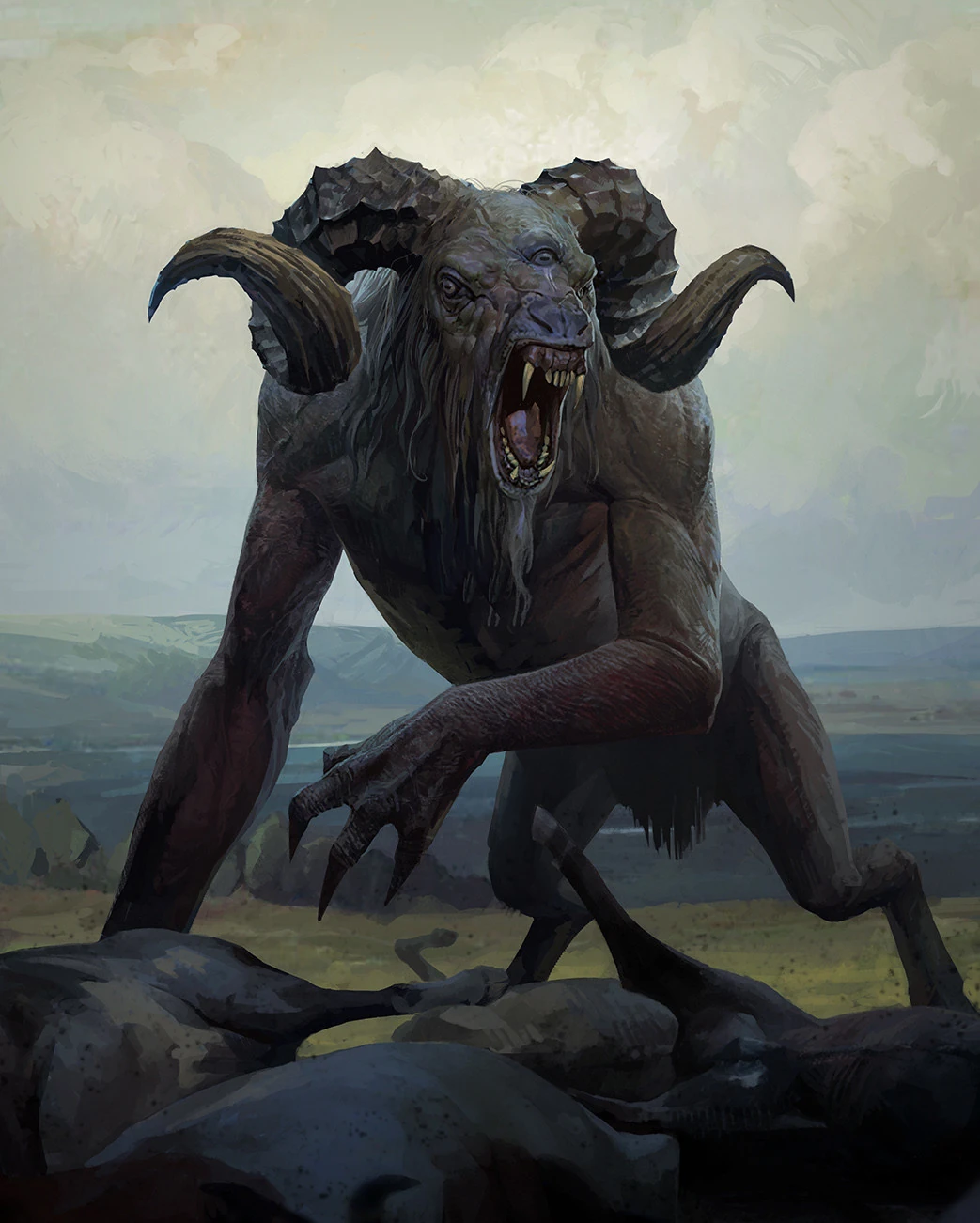
Chort
Sort of a palette swap of the Fiend, the Chort (based on a demon from Slavic folklore, later adapted into a minion of Satan by Christianity) looks similar, just swapping the deer-themed head for a ram-themed one. They're also smaller (although still larger than a human), but are just as dangerous. In one sidequest, Geralt actually tries to track down a fiend only to find out that it fought a Chort for territory and the fiend was ripped apart for its troubles. In-universe legends often mistake chorts for sylvans of all things, thinking that they are devilish tricksters that play pranks and are steal cabbage, but real Chorts are, well, rampaging, frothing predators that are just as likely to devour the farmers as their cabbage. In combat they're basically faster, more agile Fiends, albeit without any of the special hypnotism skills that the Fiends have. Not too much for me to say, but it's still a pretty neat enemy.
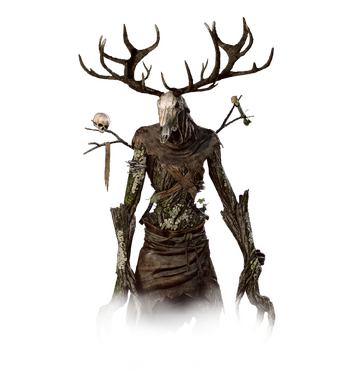
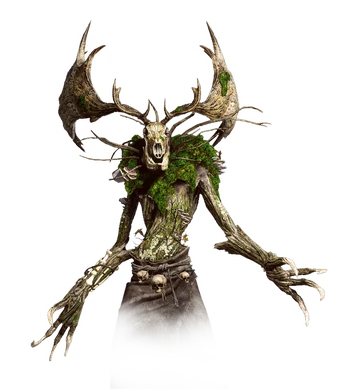
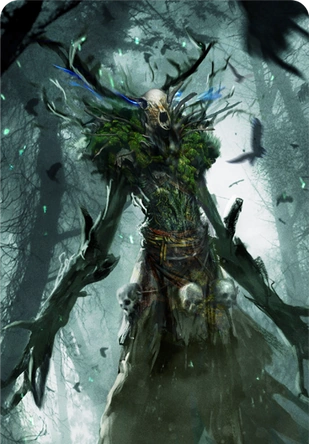
Leshen
Oh man, these motherfuckers. Borrowing its name from the far more benign Slavic forest deity Leshy (a personal favourite!), the Leshen is pretty fucking scary. Looking like a gaunt scarecrow made out of twigs and cloth scraps, the Leshen stands hauntingly tall, with long twig-claws, a deer's skull for a head and gigantic deer horns. And these ancient beings just wander around forests, attacking anyone that comes a bit too close. They're less beings and more the embodiment of primeval woodlands, and they can summon the power of nature itself to fight for it. Swarms of crows and wolves can harass Geralt, while gigantic masses of spiky brambles will appear out of nowhere to stab Geralt. And then sometimes it'll disappear and turn into smoke to reappear elsewhere. They hit hard, are hard to hit, and sometimes wander around areas that contain like low single-digit-level monsters. Leshens will absolutely fuck you up if you try to do a quest near where one hangs around, at least until you get into a decent enough level. They're noted to be particularly savage towards humans, particularly if they find that some cities and towns are encroaching too close to their territory. And it's interesting, because at least one quest shows that some tribes worship the Leshen for protecting their territory? That's something more akin to the more ambiguous real-life Leshy myths, but Witcher's Leshen is basically almost always hostile.
Uniquely, too, the Leshen is the one of the only two monsters in the base game to have more than one 'named' versions of its species show up in the bestiary. The Woodland Spirit has larger moose antlers and a neat little cape made out of moss. As you would later learn, these Ancient Leshen have a lot of extra capabilities that really sell their whole 'ancient evil forest god' vibe. The Woodland Spirit, for example, is able to 'mark' a person in the nearby village that worshiped it, causing the person to basically become like a lich's phylactery and allowing the ancient leshen to resurrect itself as long as the marked person is still alive. It's all a very interesting set of abilities that not all Leshens have, and apparently they can obtain as they get stronger.
Oh, and the Leshen also shows up in a crossover with Monster Hunter: World, because it's probably the most terrifying-but-cool thing in the game. An absolutely terrifyingly atmospheric enemy, and probably one of my favourite creatures from the game full-stop.
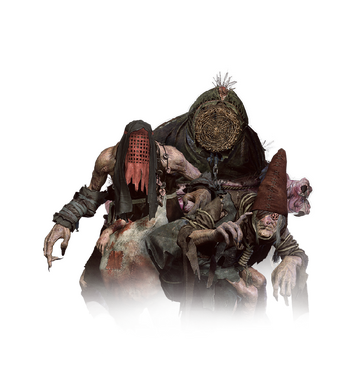
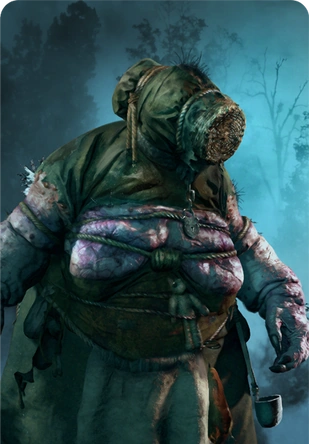
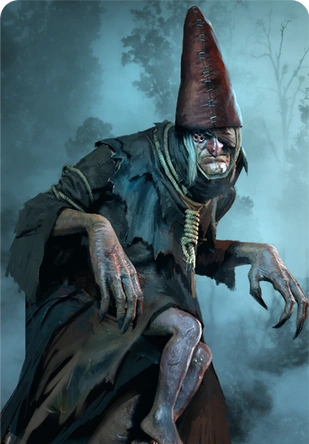
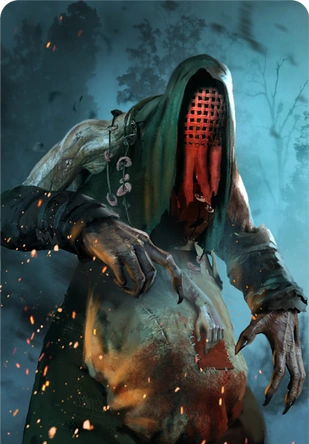
The Crones
And here we are, arriving at perhaps the only major main story 'boss' to have a bestiary entry. Based on many stories of witches and hags, the Crones are known by many names -- the Crones of Crookback Bog, the Ladies of the Wood, the Witches, the Good Ladies, and various other not-so-flattering names. Their origin and their true nature are shrouded in mystery, only that they are ancient, and completely, wholly evil. And I really do like the buildup to meeting them, where Geralt first hears of the strange, hideous local superstition about the witches in the bog, then of how sometimes villagers will send unwanted children down a 'trail of sweets' down a bog as what's essentially a sacrifice to the witches... before ultimately meeting a woman that the Crones have forced to work for them and care for a bunch of orphans that would eventually be their meal. And I do love just how spooky and unnatural the Crones ended up being despite visually just being three nasty-looking ghoulish old women. The game makes them feel so ancient and mysterious that not even a experienced monster hunter like Geralt is able to lay waste to them in his first meeting. More interesting is the fact that they actually do make good on their promise to protect the village near their bog, although how much of it is due to them being 'nice' in their twisted way and how much is just them grooming a supply of children isn't really clear. They're just nasty fuckers.
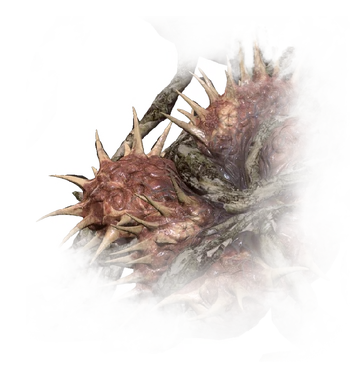 Every part of the bestiary and any in-universe source talk about the Crones as being so ancient, older than even elves and dwarves and recorded word, that even they seem to be the only creatures in the game that Geralt is actively scared and anxious about. They're willing to make deals with Geralt, too, asking them to kill the "Ghost in the Tree", itself some sort of mysterious giant beating heart covered with thorns under the root of a massive tree, claiming to be a chained nature spirit, but depending on who you ask, it used to be a Crone herself, or their 'mother'. It's, again, all very muddled and confusing, and the conflicting accounts that Geralt finds about the true nature of the Crones' mother also adds to the confusion.
Every part of the bestiary and any in-universe source talk about the Crones as being so ancient, older than even elves and dwarves and recorded word, that even they seem to be the only creatures in the game that Geralt is actively scared and anxious about. They're willing to make deals with Geralt, too, asking them to kill the "Ghost in the Tree", itself some sort of mysterious giant beating heart covered with thorns under the root of a massive tree, claiming to be a chained nature spirit, but depending on who you ask, it used to be a Crone herself, or their 'mother'. It's, again, all very muddled and confusing, and the conflicting accounts that Geralt finds about the true nature of the Crones' mother also adds to the confusion.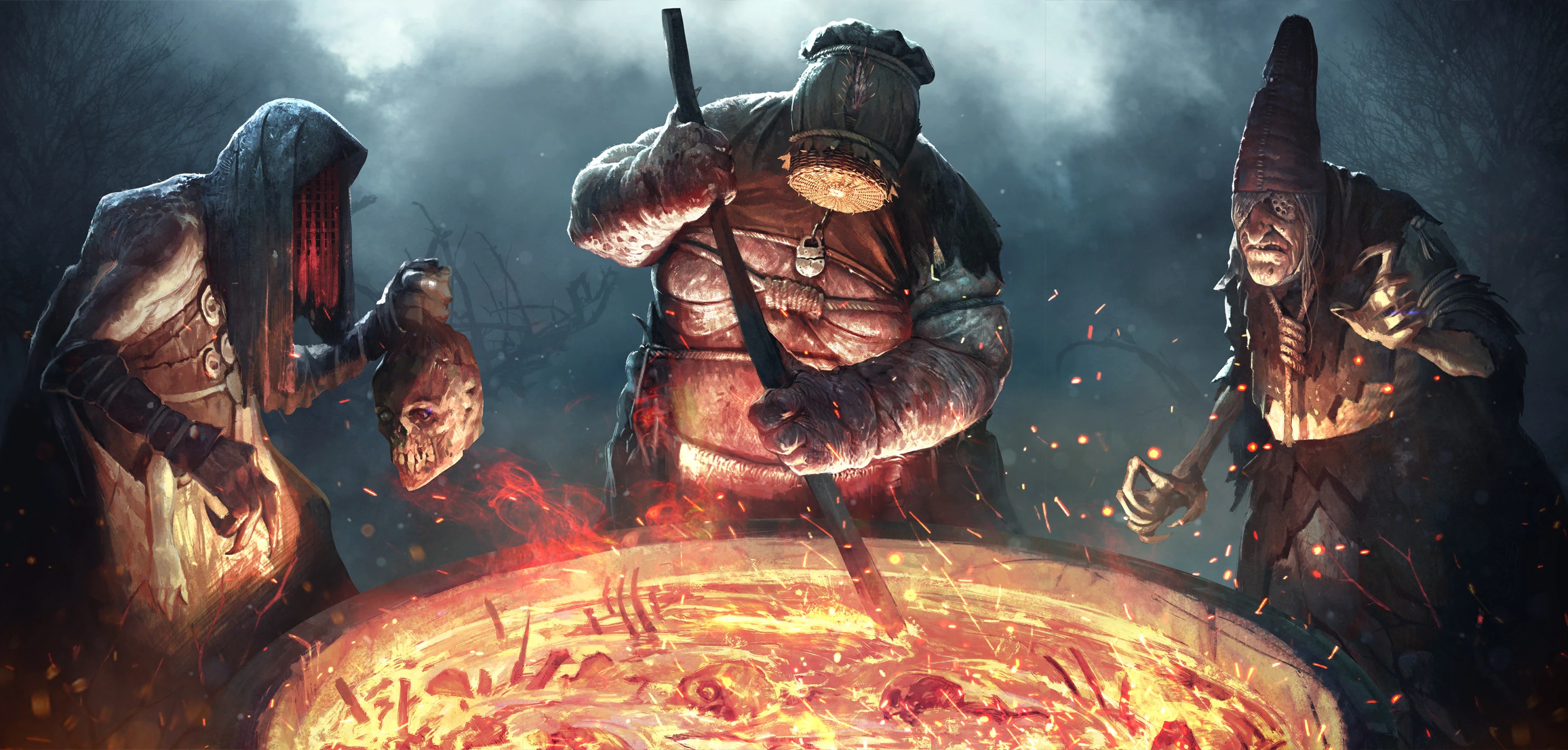 Inspired by both Baba Yaga from Slavic myths, general hags and witches, as well as various depictions of 'three old women being mysterious' (like Macbeth, or the Three Fates), even their designs are pretty nasty. From left to right, the Crones are the Brewess, Weavess and Whispess. Brewess is the most nasty-looking, being corpulent, with stumpy arms and a literal stump of wood for her head. And those old-granny boobs being lashed down with ropes are very uncomfortable to look at. Her voice is also the most... uncomfortable sounding At a glance, Weavess looks just like an old granny with ghoul arms and a garden gnome hat, but then you realize she's got an extra pair of legs jutting out from where her stomach is, just dangling there... and her exposed eye is actually a gigantic flesh pustule with many holes in it and flies swarming in and out of it. It's very disgusting. The oldest of the three, the Whispess, covers her face with a hood, but the more you look the nastier she becomes. Multiple necklaces of ripped-off ears (she demands it as tribute from anyone who asks her a favour), random children arms popping out of her apron... yeah. Again, the Crones are pretty cool as atmospheric enemies, and honestly, as uncomfortable as they make me, are also some of the most effective monster antagonists in the story.
Inspired by both Baba Yaga from Slavic myths, general hags and witches, as well as various depictions of 'three old women being mysterious' (like Macbeth, or the Three Fates), even their designs are pretty nasty. From left to right, the Crones are the Brewess, Weavess and Whispess. Brewess is the most nasty-looking, being corpulent, with stumpy arms and a literal stump of wood for her head. And those old-granny boobs being lashed down with ropes are very uncomfortable to look at. Her voice is also the most... uncomfortable sounding At a glance, Weavess looks just like an old granny with ghoul arms and a garden gnome hat, but then you realize she's got an extra pair of legs jutting out from where her stomach is, just dangling there... and her exposed eye is actually a gigantic flesh pustule with many holes in it and flies swarming in and out of it. It's very disgusting. The oldest of the three, the Whispess, covers her face with a hood, but the more you look the nastier she becomes. Multiple necklaces of ripped-off ears (she demands it as tribute from anyone who asks her a favour), random children arms popping out of her apron... yeah. Again, the Crones are pretty cool as atmospheric enemies, and honestly, as uncomfortable as they make me, are also some of the most effective monster antagonists in the story.One of my favourite parts of them is simply their vibe. As boss-fights they're... not particularly threatening. Brewess is essentially a reskinned Water Hag, able to dive in and out of pools. Weavess, meanwhile, combines several abilities of the Leshen, bursting into crows and flying around you. And yet they still feel so threatening by the simple creep factor. Combat-wise Crones aren't particularly any more difficult than any given boss, but the simple factor that they're worshiped by the locals, who treat the hideous mutilations and dead youths they offer up to the Crones as basically normal. They're basically turned an entire village into a self-sustaining cattle farm that's happy to offer up their young voluntarily in exchange for ambiguous 'protection'. And, well, the combination of the great voice acting, the great tone set in the entire south-eastern side of Velen where all their story takes place in... the Wild Hunt is cool and all, but the Crones are easily my favourite antagonists, and I don't think I feel as satisfied in killing any actual character than I did with the Crones.
________________________________
Specters
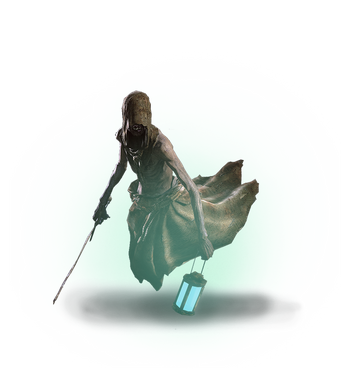
Wraith
Returning from the previous two games are the Wraiths, or the most basic of the 'specter' type enemies. And, as before, they show up mostly around cemeteries and tombs, although sadly they lose the tombstones lashed onto their backs that made Witcher II's wraith model so memorable to me. This time around, though, they carry lanterns, like Poes from Legend of Zelda. Wraiths are, as before, restless spirit of people who die with some unfinished business and are always wracked in pain. They can teleport through short distances, and, unlike wraiths in the previous game, the 'specter' type enemies are a lot more difficult to kill because it's less a matter of 'hack them with a magical weapon'. Wraiths are the weakest, but even then they can still become intangible and be completely immune to your silver sword, and you need to make use of either a Moon Dust grenade or Geralt's Yrden sign (creating a bunch of runes around a spot) that will force the Wraith to turn corporeal and stabbable. This, I feel, is a great way to still make the Wraiths a pretty simple fight while also highlighting the fact that they are dangerous, incorporeal ghosts.
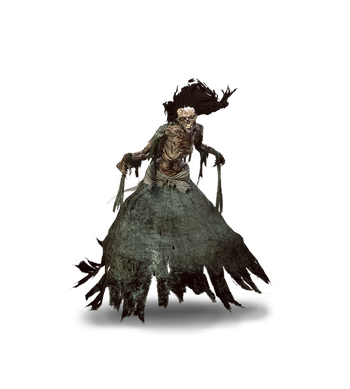
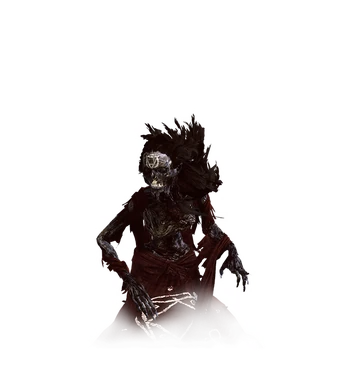
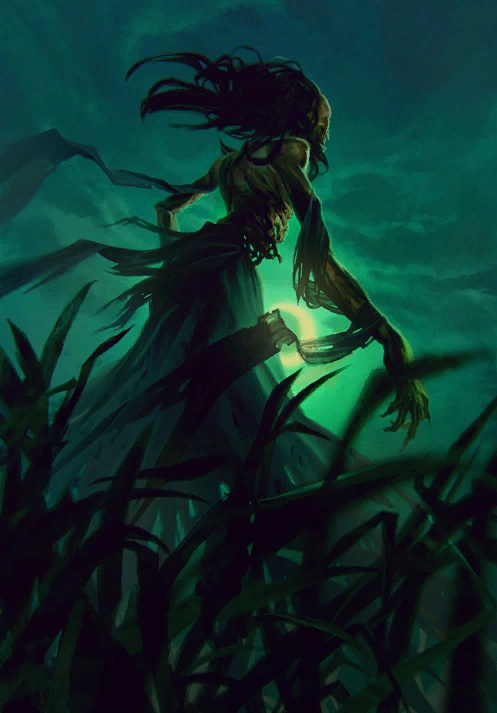
Nightwraith
A couple of 'elite' wraiths show up, and they are basically elite versions that have greater power due to the brutality of their deaths. Nightwraiths and their (unseen in this game) cousins Duskwraiths appear as a skeletal woman in a tattered dress, and are almost always exclusively found in rural areas, particularly fields and meadows. The couple of named Nightwraiths Geralt fights in the game have pretty brutal and tragic circumstances behind their deaths, are driven to basically wipe out every living thing nearby. In addition to fighting the Nightwraiths themselves, Geralt has to do a ritual to essentially appease and unbind their spirits from the mortal realm. And while they're not exclusively found in the night, it's where they are the most powerful.
More importantly, fighting one of these nightwraiths is difficult, since they hit hard, and are completely intangible without the help of Yrden or Moon Dust. Which is a bit more difficult than it sounds, because nightwraiths move around a lot and hit pretty hard. At various points in the battle they will disappear and summon clones that will heal the main Nightwraith body and Geralt has to quickly kill the clones in rapid succession to re-summon the main body.
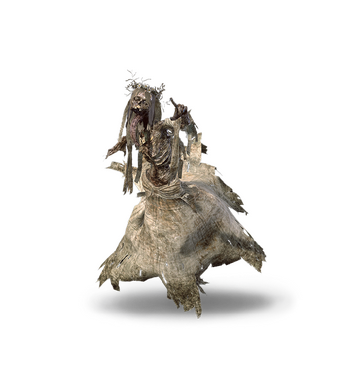
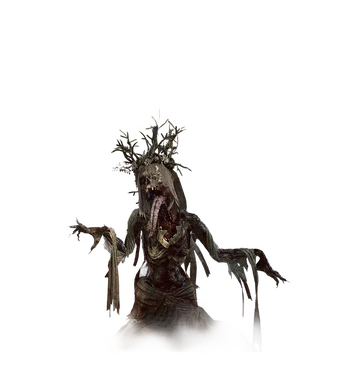
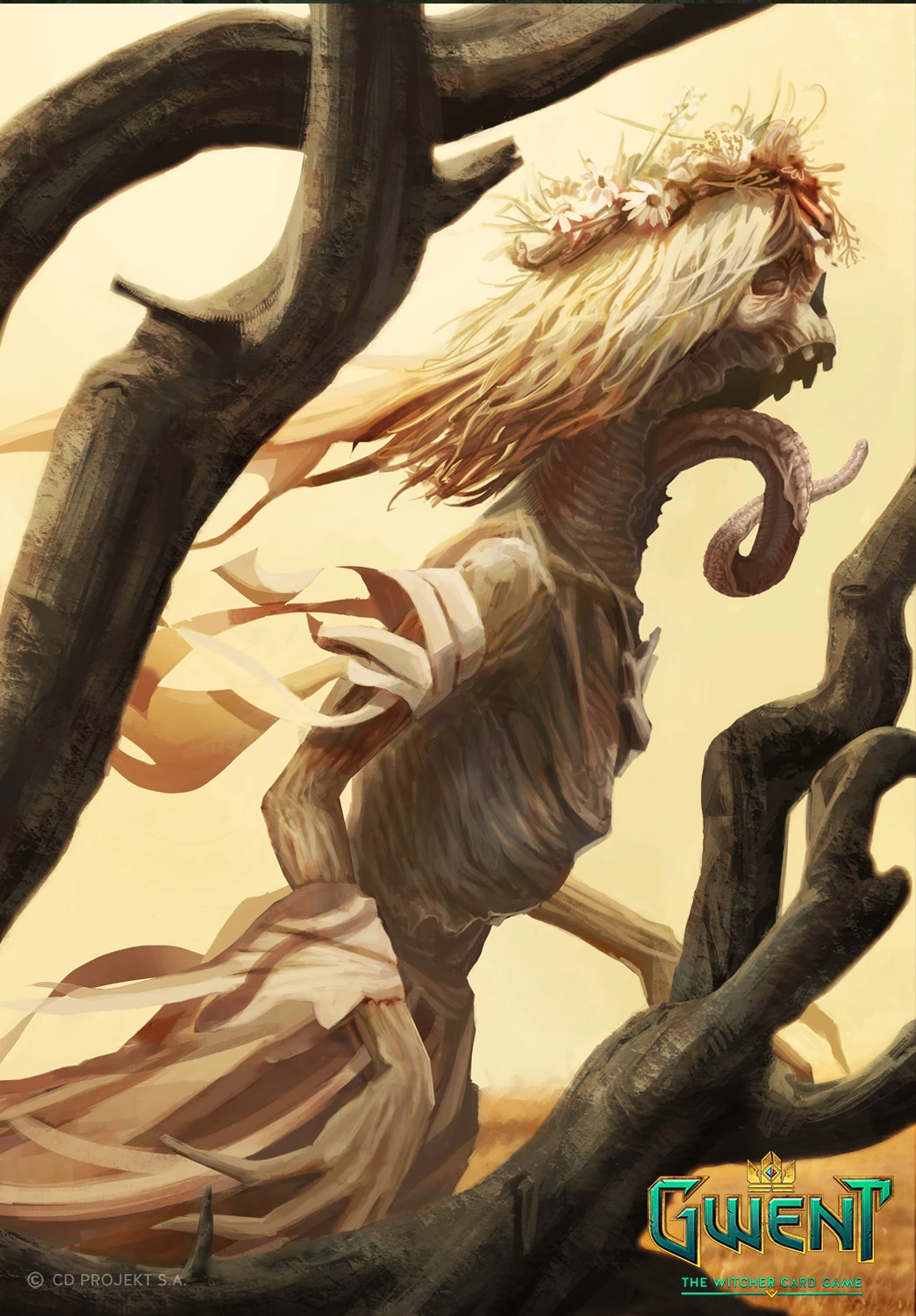
Noonwraith
The Noonwraiths, on the other hand, look a lot more wretched. they're not just women with tattered dresses, they also have a crown of thorns on their head, are missing their lower jaw, have decaying skulls and a long, nasty-looking tongue protruding out of their neck. As their name implies, Noonwraiths are most powerful in the noon, and are specifically young women who died before their weddings, and, driven mad with pain and anger, they roam the living world hunting their unfaithful lovers or backstabbing rivals. Since they are wraiths, any living thing they meet is also fair game. And to truly banish a Noonwraith, Geralt will have to find like the object of emotional significance binding them, like their wedding veil or wedding ring. The bestiary also lists two specific named Noonwraiths, the "Devil by the Well" and "the White Lady". And for both, Geralt also has to play detective and solve the circumstances behind their transformations into noonwraiths and had to essentially give them a proper burial.
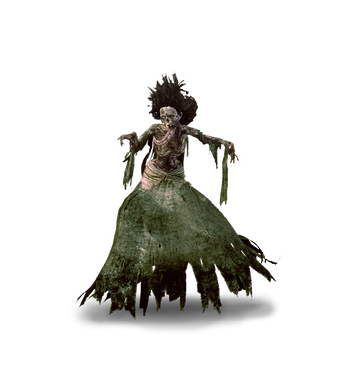
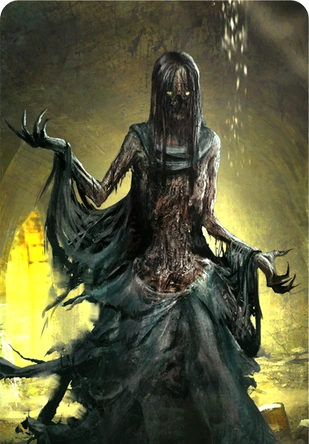
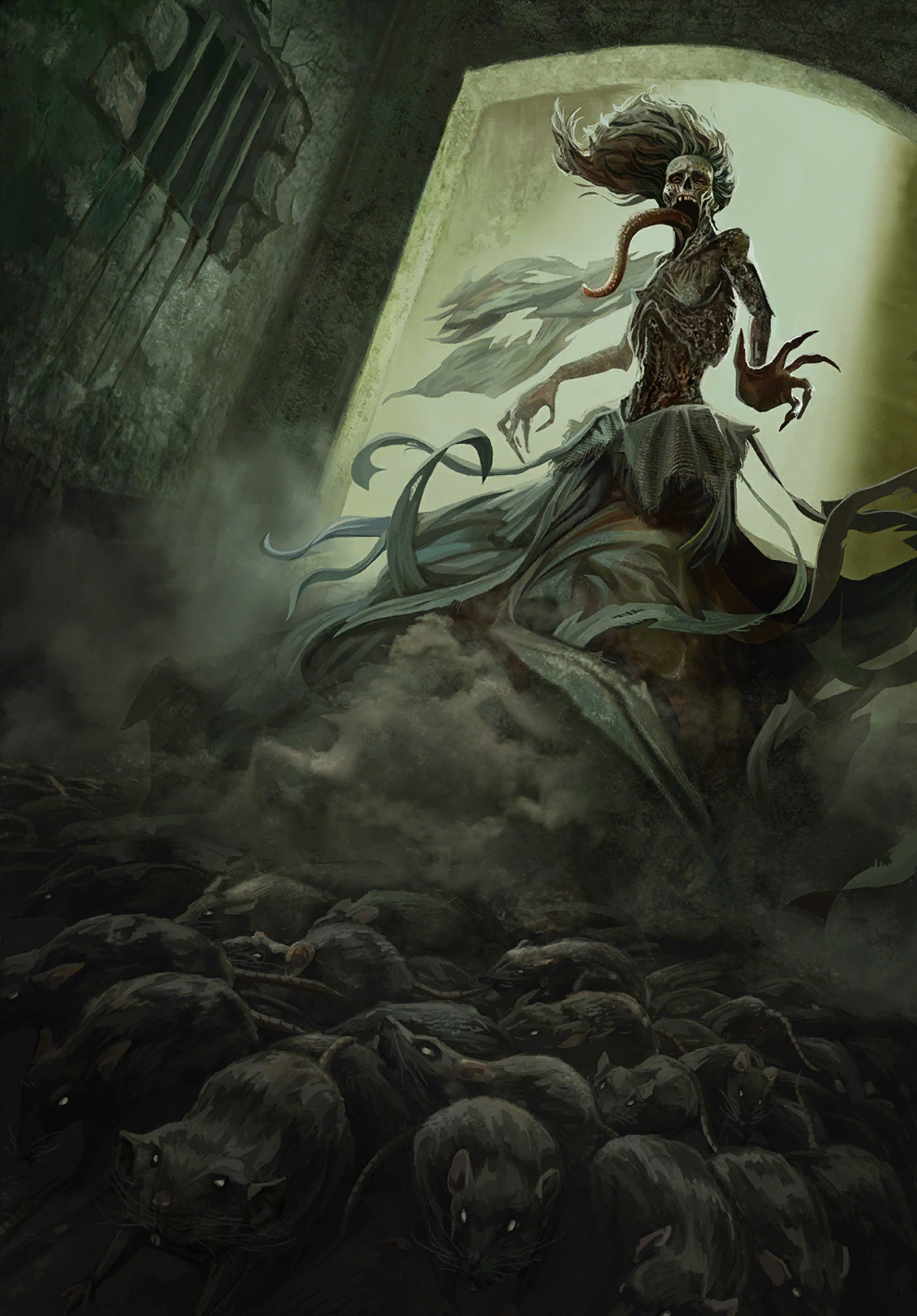
Plague Maiden
It's easy to handwave the Plague Maiden (or the Pestae) as just a slight modification of the Noonwraith model. And while that is certainly true, the vibe of the Plague Maiden is completely different. You meet one at the end of a somewhat long quest chain, and the bestiary gives us a fair amount of lore surrounding the Pesta. Sometimes, when a plague ravages a region, a Plague Maiden will be born -- a mysterious ghost resembling an ill woman with rotting flesh, whose body is covered with worms, and rats scurry out from the miasma under her robes. She's a spirit of pestilence, and in-universe it's not entirely clear that they're real or not... until, of course, Geralt meets one.
Without spoiling too much about the questline she's involved in, the Plague Maiden's creation is a combination of both a traumatic and extremely violent death (similar to other wraiths) and a death involving plague-bearing rats, binding the woman who would become a Plague Maiden to the location of experimentation with the plague, and the Plague Maiden is savvy enough to pose as a regular, confused spirit before ultimately revealing her true form as something far, far worse. While fighting her might be similar to fighting a Noonwraith or Nightwraith, Geralt can only stave off the Plague Maiden permanently and had to bring her peace to truly release her spirit.
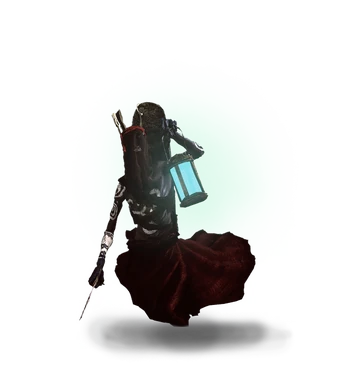
Penitent
Yet another unique wraith variation, the Penitent is a type of wraith that specifically haunts and taunts a person who has done bad deeds, like a very passive-aggressive (okay, very aggressive) Ghost of Christmas telling you to repent. Like the Pesta, Geralt also only encounters the Penitent in one specific questline, where a Penitent has covered a lighthouse with a massive fog and darkness, having been brought into being by the curses towards a particularly nasty man who caused the deaths of many. Visually it's just a slightly-reskinned regular Wraith, but since it's tied to a certain quest, like the named Noonwraiths, Geralt has to make sure what is binding the Penitent to the location. Again, in addition to just making the questlines something more than just 'smash stab kill enemy', I really do love these sort of short, self-contained detective-slash-exorcist work.
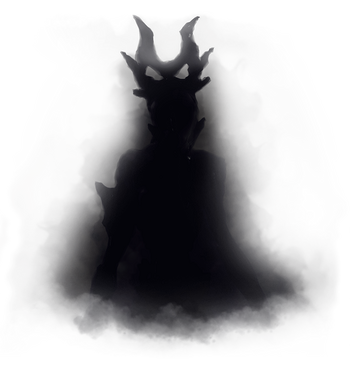
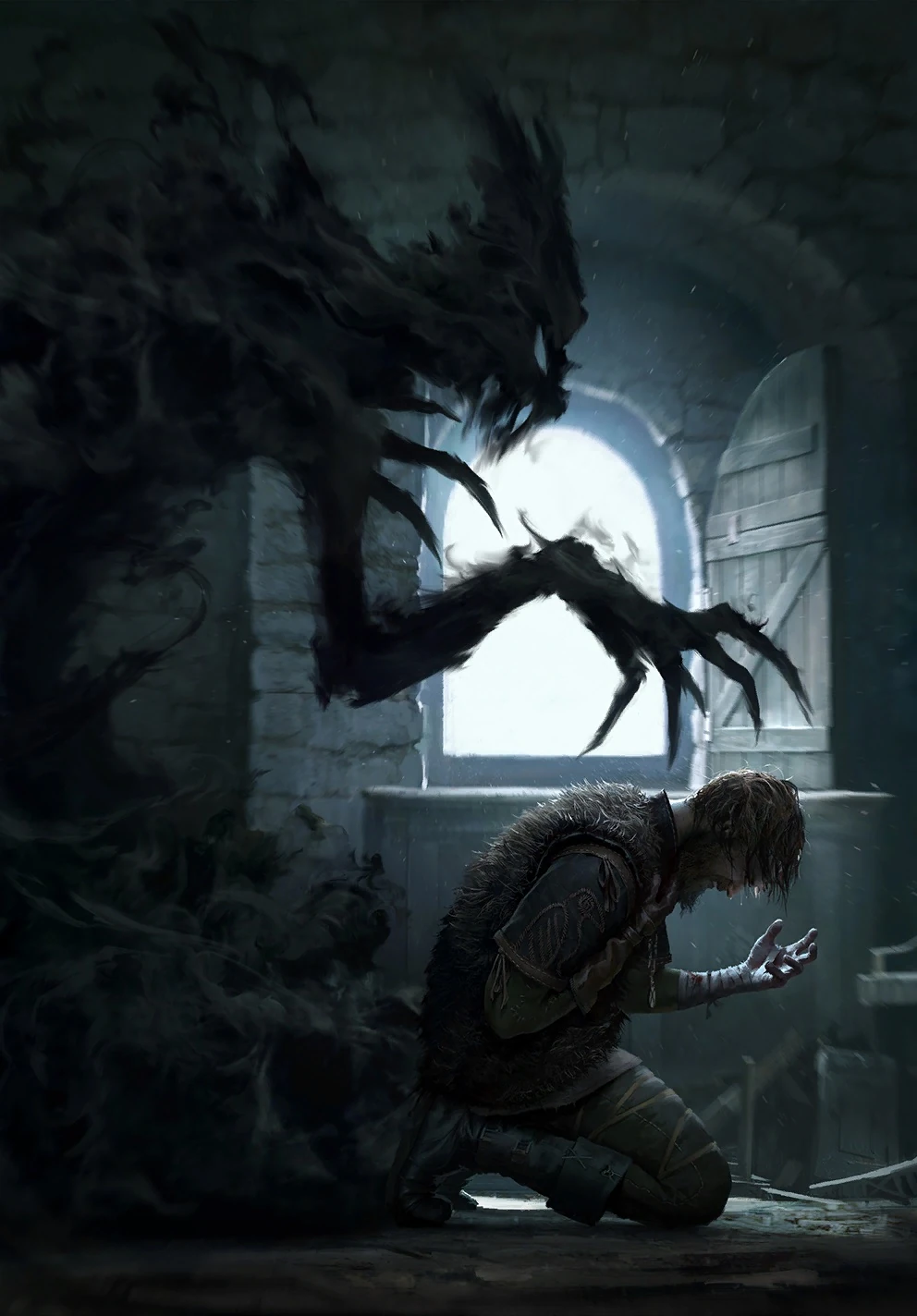
Hym
The final specter (identified as a demon in some in-universe sources) we're going to talk about is the Hym (pronounced haime), which is a type of specter that's only found in a single quest in the base game. I don't think this one is actually based on any specific creature in mythology, although it has all of the best traits of lots of real-life mythological monsters. Whether it's a 'demon' or a 'specter', the Hym is primarily a spirit of guilt. Without spoiling too much of the story that the Hym is involved with -- which is easily one of my favourite quests in the game -- you discover that the Hym has latched on to someone like a parasite, feeding on his guilt and masquerading alternatively as the voice of the gods (something not too unnatural in Skellige) or a vengeful, restless ghost (Geralt's first suspect) but turns out that neither one is the right answer and it's a Hym, a spirit that parasitizes a host and slowly feeds on the host's emotion while driving him/her into deeper and deeper despair.
And I really do like the design of the Hym, which is just... a shadow with two horns on top of what's otherwise a pretty humanoid face. The shadow is extremely tall and gangly with long claws, very Slenderman-esque, but the coolest thing about the Hym is the simple fact that it always lurks in the shadows. He forces the host to live in the dark, and the only clue that it's not simple madness or a more regular ghost that's haunting the victim is that when the dude walks around in the light, the Hym has warped the shadow that the person is casting. That is so cool! The Hym also constantly talks to the back of its victim's mind, driving him mad with depression, fear and guilt -- and since the Skellige Hym also delights in pretending to be the voice of the gods, gets his victims to slowly self-mutilate as 'punishment' for his crimes, as the gods decree.
There's also a very cool set of options in which you can fight the Hym. There's the usual fighty-fight where you basically fight a teleporting enemy in a very atmospheric, shadowy haunted house... or you try and trick the Hym into latching on to another host who believes in a crime but isn't actually guilty. And when the guilt is gone, the Hym, thus hostless and unable to feed on guilt, is destroyed. It's... interesting how the characters in-universe manage that, we'll just say without spoiling anything.
________________________________
Vampires
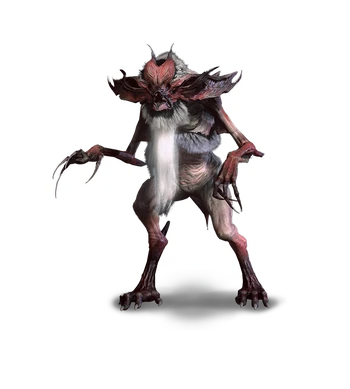
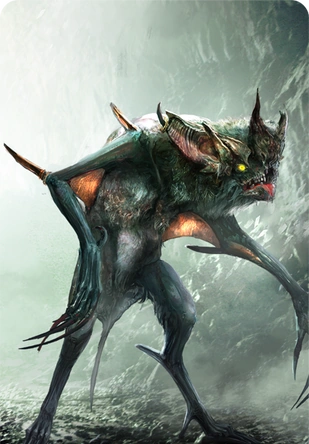
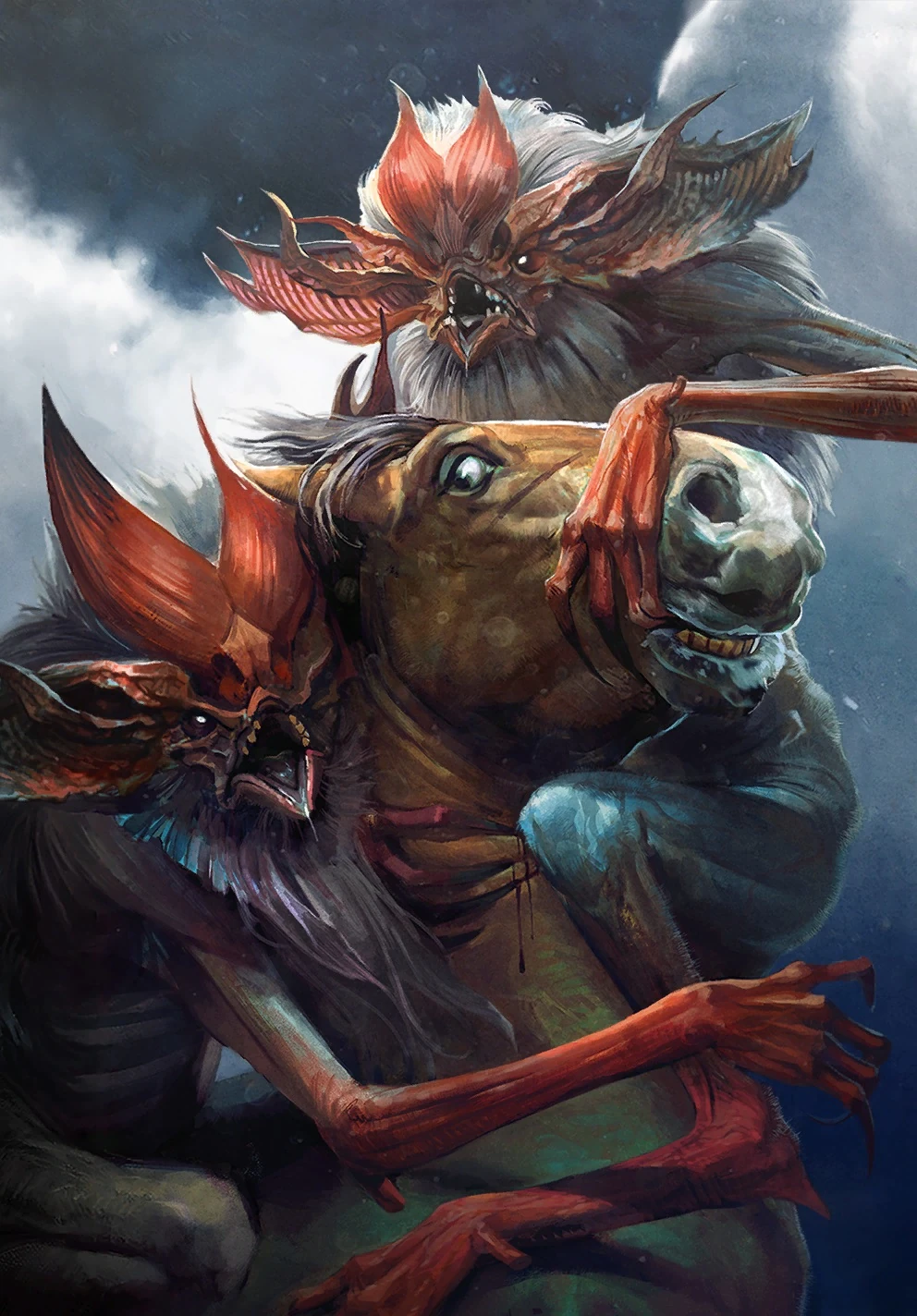
Ekimmara
Our final category for the base game are vampires, which are pretty relevant in the books and in the general lore of Witcher III... but in the base game, most of the vampires you'll be facing are lesser vampires. You don't actually get to meet too many of the greater vampires, at least not until Blood and Wine, the vampire-themed expansion. The Ekimmara (or just Ekimma) are the weakest of the bunch, and instead of looking like suave Draculas, Ekimmaras are basically monstrous man-bats. With the face cobbled together from several hideous-looking real-life bats (including a very exaggerated version of the leaf-nose bat), hideous mouths, large, long claws, little bat-wing-like growths in their armpits and a big-ass beard for some reason, the Ekimmara looks pretty great as a monster! That face is perhaps the most nasty and memorable feature. I'm not sure if they had a specific bat species in mind or just combined some of the nastiest, but it sure looks cool.
The vampires in the world of the Witcher, like most of its monsters, aren't undead humans and are instead post-Conjunction monsters, and therefore all the superstitions revolving water, garlic and holy symbols are poppycock as far as Ekimmaras are concerned. They do resemble hideous mutant-bats, and they do feed on blood... although not with a Dracula kiss, but by tearing them to shreds and lapping up the blood like an animal. Despite looking pretty gangly and fragile, Ekimmaras are noted to be physically powerful, able to smash plate armour with their fists, and being vampires, have exceptional regeneration. Oh, and I think all vampires are actually immune to the Witcher's normal 'monster-sense'. In the in-game Gwent card game, even in the base game we have a couple more vampire variants -- Bruxa, Garkain and Fleder -- but they'll all show up in the DLC.
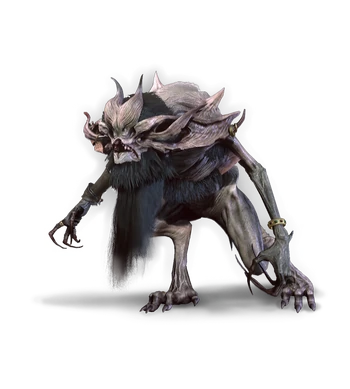
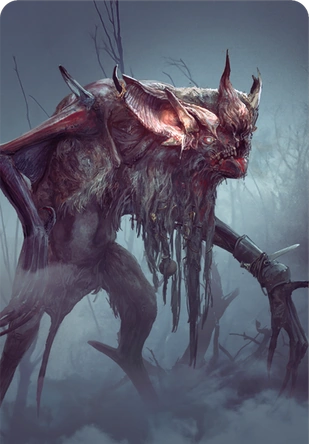
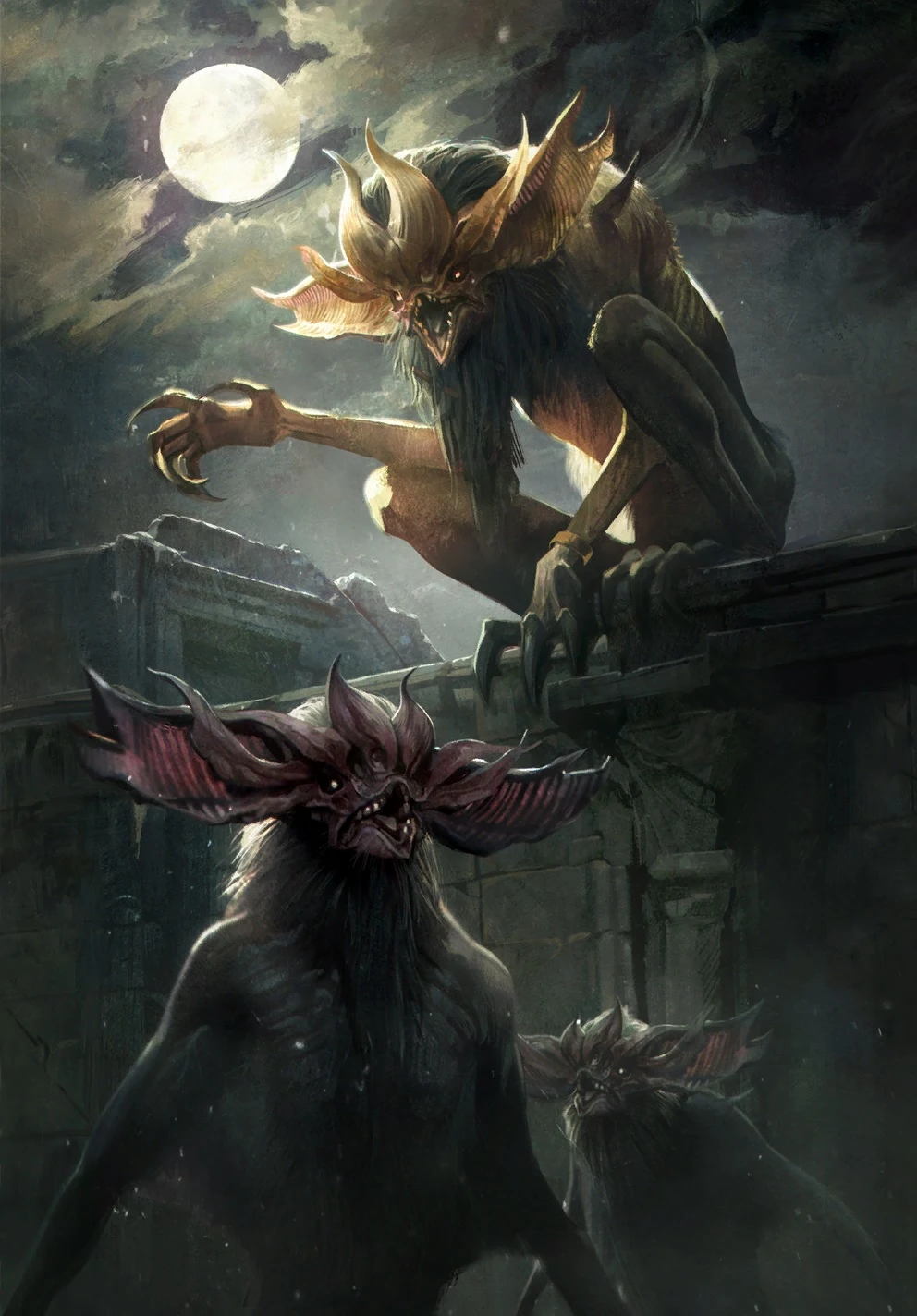
Katakan
The Katakan, borrowing its name from Katakhanas, the Cretean word for Vampire... on the surface, looks like it's just a reskinned Ekimmara, right? Perhaps slightly bulkier and spikier, with a more bleached-white skin... but unlike Ekimmaras, Katakans and Nekurats ("Nosferats" in the novels) are able to transform into a humanoid form and pretend to be humans. There's a neat sense of progression as we move up the vampire heirarchy. The Katakans are also weak to the sun (which slows down their regeneration) and tend to hide in the shadow, but also gain an extra power -- invisibility, although they still cast a shadow.
While in their true forms they look like Ekimmaras, Katakans are a lot less brutish and are intelligent, and are actually able to rein themselves in and drink blood from bite marks without mutilating their victim. The most notable Katakan in the game was even able to basically behave as a serial killer in Novigrad! Again, I do like that there are so many types of vampires in the land of the Witcher, and each of them basically carry a different set of vampire trope abilities.
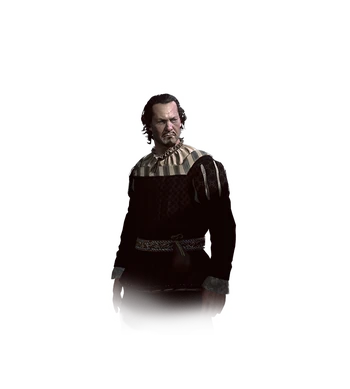
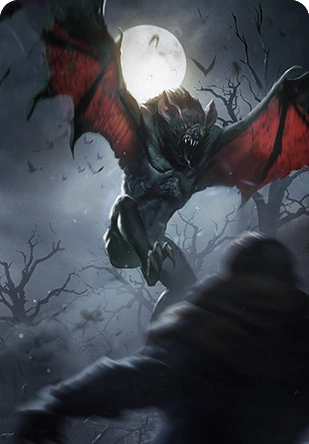
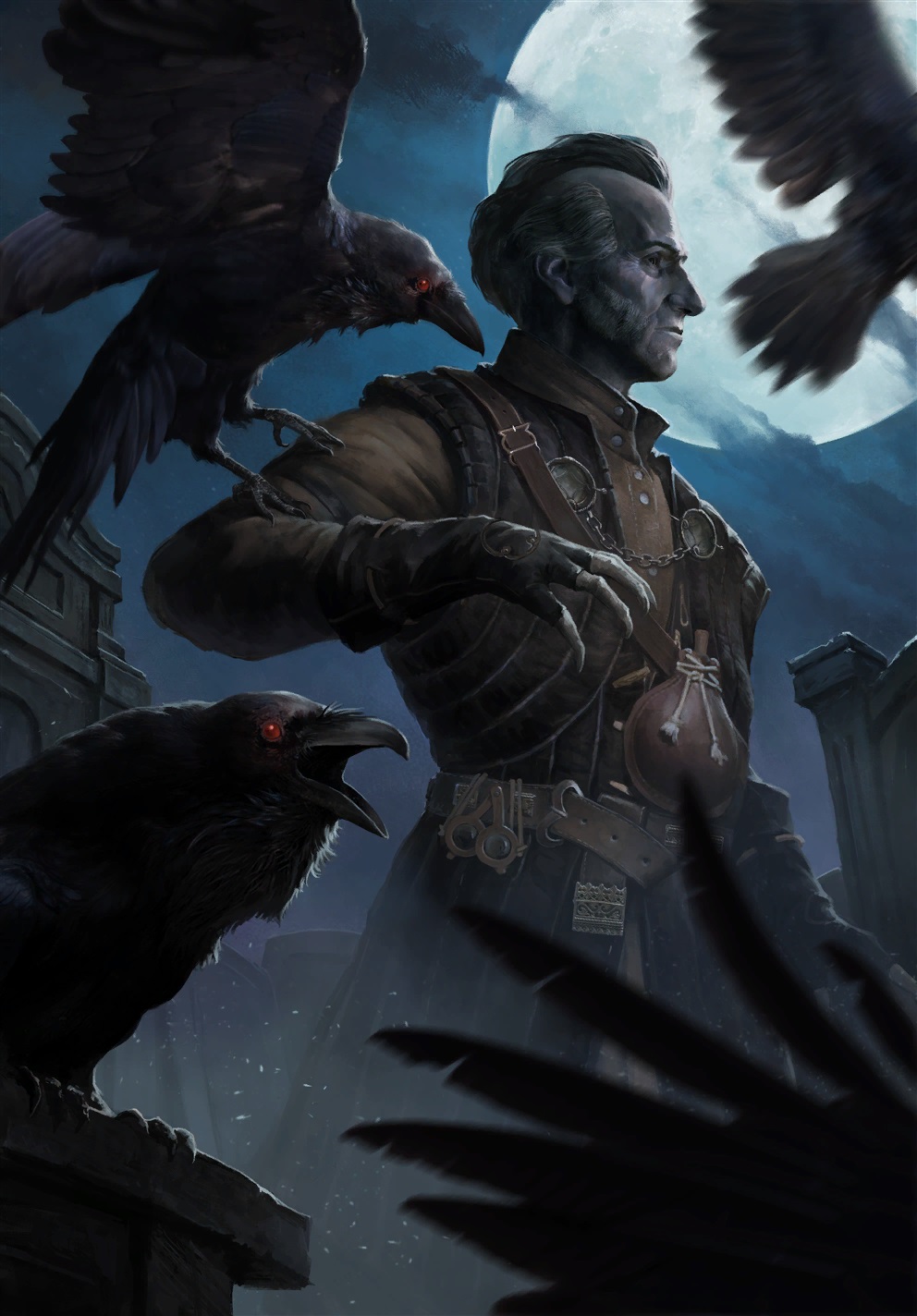
Higher Vampire
The most powerful of the vampire kin, the Higher Vampires (note the capitalization) are a special breed of the higher vampires. In the base Witcher III game, the game leaves it ambiguous about the handful of vampires that claim or seem to be Higher Vampires -- one you meet under Novigrad's tunnels seems to be one, but is identified by the game and the loot he drops as a Katakan. The second one is part of a pretty long side-quest and certainly is far, far more intelligent and cunning than any other vampire you meet, and also claims to be a Higher Vampire... but he dies very quickly and also drops a Katakan Mutagen. As the Blood and Wine expansion would later establish, Higher Vampires are extremely unique, casting doubt on whether the two self-styled higher vampires you meet in the base game are actually higher vampires. Not having played the expansion myself, I'll not comment on why or how.
In retrospect, I suppose it's very obvious that they were going to do a vampire-themed expansion and that notable higher-vampire from the novels, Emiel Regis, is going to show up there. Higher Vampires in the land of the Witcher are noted to also have the same thirst for blood that lesser vampires have... but are a lot more intelligent and humans. They walk, talk and live like humans, hanging out in populated cities under the sun. They like to drink blood but don't have to feed on it to survive. And being vampires, they are completely invisible to even Witchers. But they are also completely immortal. Thankfully, despite being vampires, higher vampires are extremely rare and not all of them are dangerous to humans, with, again, the most prominent higher vampire in the series being an ally.
A higher vampire basically has everything that vampires in fiction can do. Hypnotize men, control animals, super-strength, super-speed, invisibility, the ability to turn into a giant bat... and even if a Witcher can successfully best a higher vampire, all they have to do is wait a couple of decades to regenerate, and apparently only a higher vampire can kill another higher vampire permanently. I'm not entirely sure how this works because, again, in the base game I only have the bestiary entry to go with, but... hey, if nothing else, it sure is a motivation for me to go and buy Blood and Wine!
And with that... we've finished the bestiary for Witcher III! This was fun. The Witcher games in general are very, very fun for these sort of monster review segments.
No comments:
Post a Comment